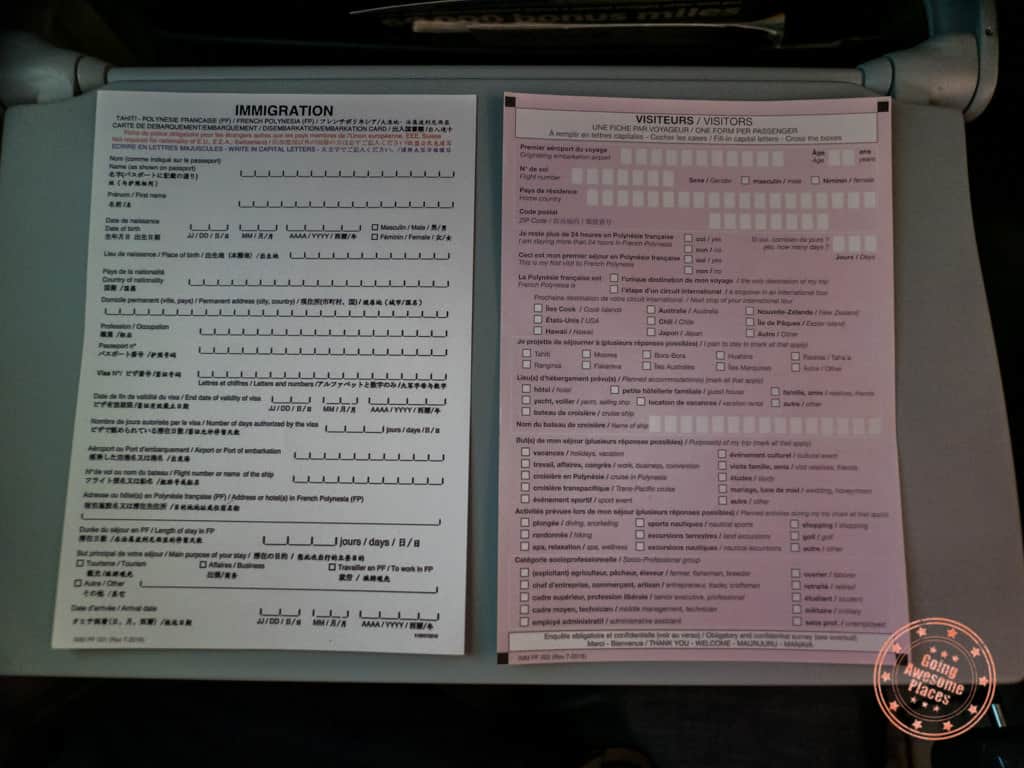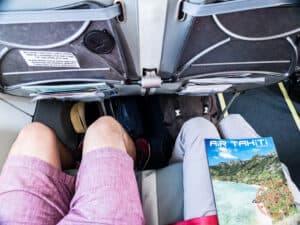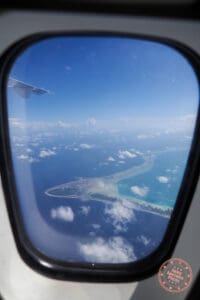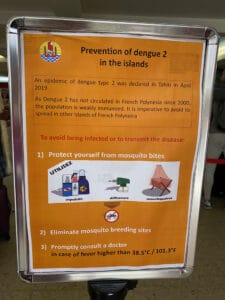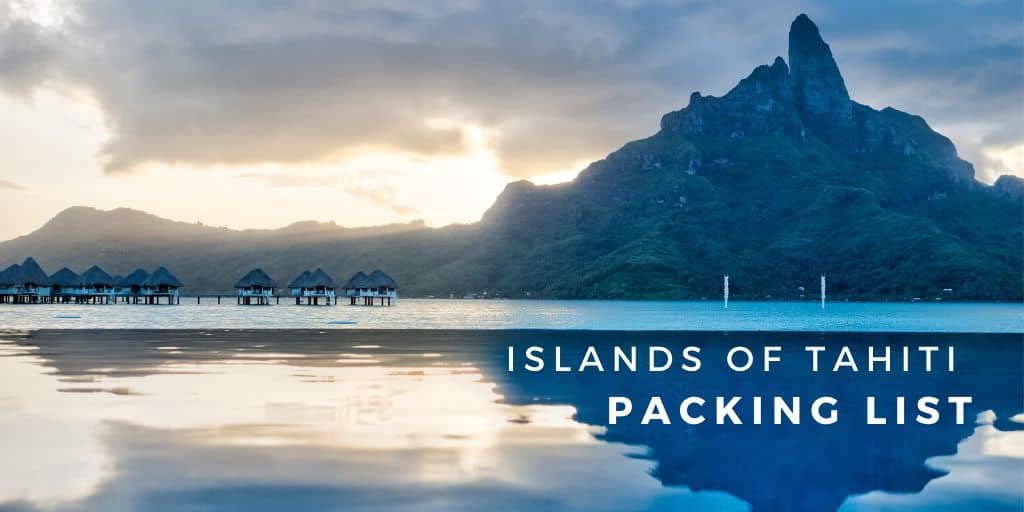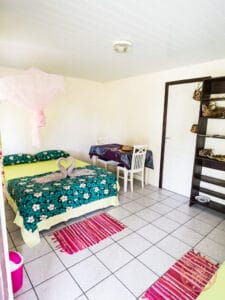With 118 islands scattered across the South Pacific in 5 distinct archipelagos, a trip to French Polynesia is a paradise choose-your-own-adventure. Turquoise-blue lagoons, palm-fringed beaches, romantic overwater bungalows, lush mountains, and unblemished coral habitats fill your days. It’s what dream vacations are made of.
While the end-product is undeniable, the trip planning process to building your French Polynesia itinerary isn’t always as smooth sailing. With so many islands to choose from and so many different ways to experience the country, you’ll be overwhelmed with information. To help, I’ve put together The Islands of Tahiti travel guide to summarize the main things you need to know before you go and insider tips that only someone that’s been can tell you.
Read more about French Polynesia
- How to Plan A 2 Week Tahiti Itinerary
- The Islands of Tahiti Packing List
- Le Meridien Bora Bora Resort Review
- Best pensions in Rangiroa
- Where to stay in Fakarava
How to get the best deals in travel
- Hottest deals – Bookmark the travel deals page.
- Car rentals – stop getting ripped off and learn about car rental coupon codes.
- Hotels – Use corporate codes or get Genius 2 tier with Booking.
- Flights – Have you ever heard of the “Everywhere” feature?
- Insurance – Make sure you’re covered and learn more about where to buy the best travel insurance.
Table of Contents
There’s a TON of information here so if you have a specific question you had, feel free to jump to the topic you’re most interested in.
In This Article
- Things to Know Before Going to French Polynesia
- The facts
- French Polynesia geography
- How do you decide where to go?
- Ranking the top islands
- Getting there
- Getting between islands
- Moving within an island
- Health and safety
- Language
- Food you need to try before you leave
- Connectivity
- Money
- How do you save money?
- What to pack for your trip?
- Where to stay in French Polynesia
- Best time to go
- How much does a trip to French Polynesia cost?
- 5 main take aways
Things to Know Before Going to French Polynesia
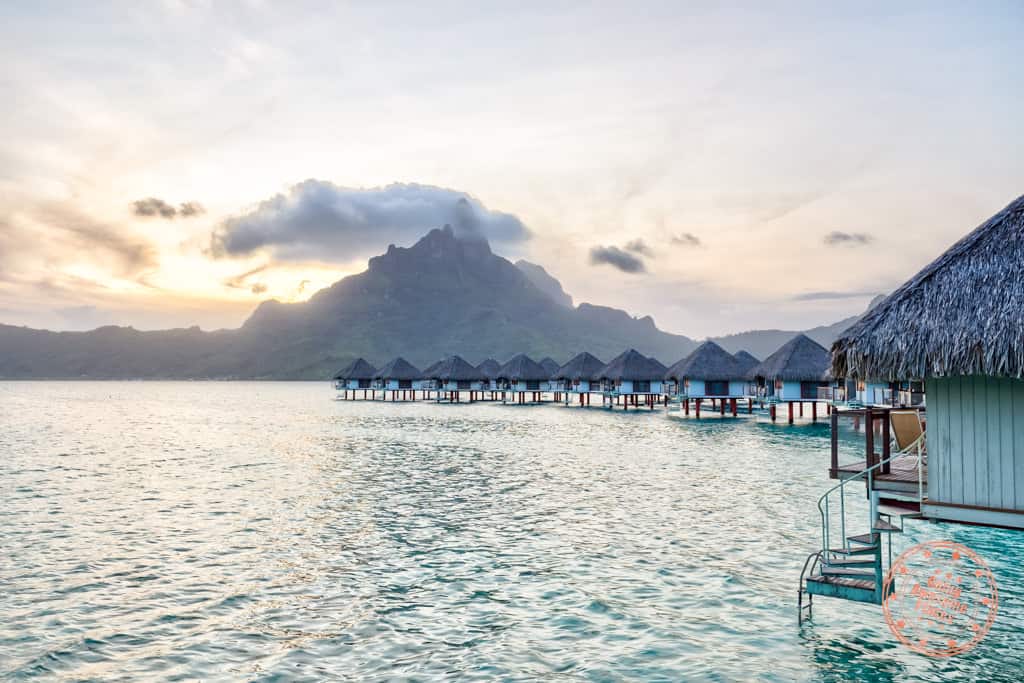
This is meant to be a comprehensive Islands of Tahiti travel guide of practical things you need to know before you go. We’ll start from the basics and then dive into all facets of travel that you’ll encounter.
The facts
- Electricity – 220 volts, 60Hz
- Currency – Pacific franc (XPF or CFP)
- 1 XPF = $0.009 USD = $0.013 CAD = 0.008€ EUR
- For North Americans, the easiest way to convert currency is to remove the last 2 zeroes to arrive at the USD equivalent.
- Timezone – 10 hours behind GMT. This means 2 hours behind PST, 19 hours ahead of Tokyo and Australia’s east coast, and 22 hours ahead of New Zealand.
- ATMs are easy to find on Tahiti and near airports but more challenging on other islands. You will need to plan your cash well.
- SIM card – The two main companies in The Islands of Tahiti are Vini and Vodafone. All companies have pre-paid packages available.
- Alternative data options – Tahiti Wifi – If you’re looking for a hotspot device that you can share with your group, Tahiti Wifi is offered from Tahiti’s international airport and is quite affordable.
- Measurement system – Metric scale for distance and the Celsius scale for temperature
- Tipping – Tipping is not expected or standard practice in the country. That said, you can certainly tip for good service and in those situations 10% is the unspoken benchmark.
- Language – The official languages are French and Tahitian.
- Government – While part of French Republic’s overseas territories, French Polynesia is an independent country with its own government and legislative assembly. However they do rely heavily on France for trade and protection. Subsequently, much of the country’s laws and processes are French.
French Polynesia geography
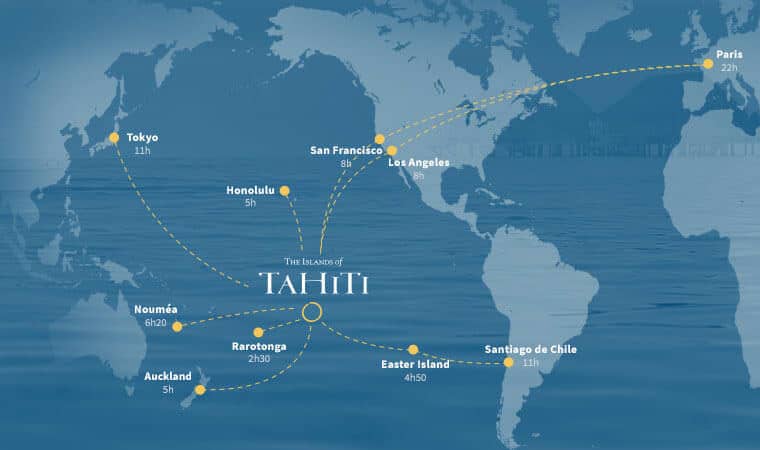
The first thing that I have to set the record straight on is the naming. The official name of the country is French Polynesia when in 1957, the islands were reconstituted into a French Overseas Territory. The name The Islands of Tahiti is often used as an alternate to describe the uniting of five distinct island chains.
However, I’ll be the first to admit that it does cause some confusion because 1) Tahiti itself is the name of the largest island and is home to the bustling capital of Papeete, 2) Tahiti is part of the travel marketing lexicon and what most people were raised with, and 3) the local people of the nation are known as Tahitian as opposed to French Polynesian.
For the purposes of this guide, I’ll be using both interchangeably.
When you think about French Polynesia, I guarantee you that most people will have a hard time pinpointing exactly where in the Pacific Ocean it’s located. If you take a look at the map above, it’s comfortably nestled in the middle of the ocean and below the equator which puts it in the southern hemisphere. You’ll also notice that it’s almost a straight shot south from Hawaii (Honolulu).
The 5 archipelagos
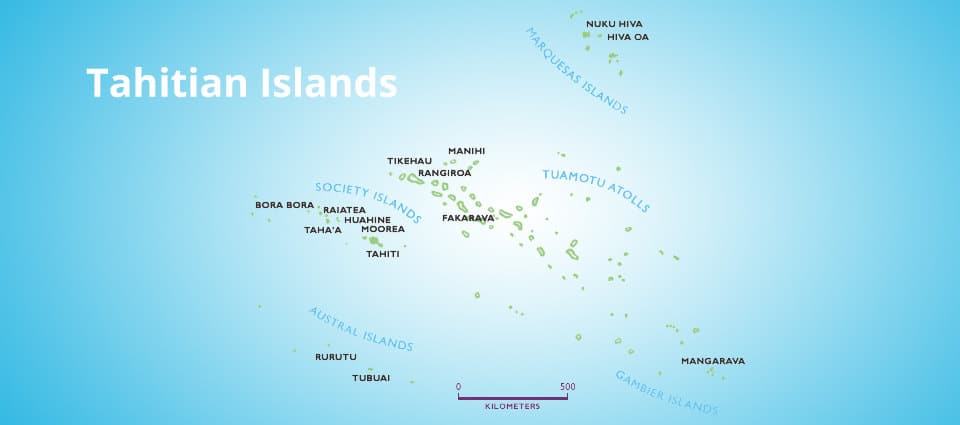
Sprinkled in the Pacific Ocean are 118 islands and they’re organized in 5 archipelago clusters – Society, Tuamotu, Austral, Gambier, and Marquesas.
The most well-known are the Society Islands which consists of popular destinations such as Tahiti, Moorea, and Bora Bora. Next is the Tuamotu Islands which are technically all coral atolls that barely rise up a few meters above sea-level. From there, you have those that are less-travelled. Gambier Islands extend from Tuamotu Islands. The Marquesas Islands the furthest away from the centre and remarkably more lush, rocky, and mountainous. You then have the Austral Islands which are located the furthest south.
To put into perspective how expansive the islands are and how much distance they cover is when you superimpose a map of Europe over the region. You’ll be surprised to hear that The Islands of Tahiti is a close equivalent to the size of Europe at 5.5 million km².
Here are a few key points about each archipelago:
- Society Islands – Most central, international airport on Tahiti, location of the capital and Bora Bora.
- Tuamotu Islands – Where most Tahitian pearls are grown, atolls that best evoke Robinson Crusoe’s story, and best known for their scuba diving on Rangiroa and Fakarava.
- Gambier Islands – Another main centre for pearl farming, surviving examples of Catholicism, and home to more traditional Polynesian lifestyle.
- Marquesas Islands – A 3 hour 45 minute flight from Papeete, home of the tiki and haka, primal landscape with waterfalls, lush valleys, ancient sites, fjord-like bays, volcanic cliffs, and towering mountains.
- Austral Islands – Reputed for their crafts (weaving, hats, and patchwork), humpback whales from July to November, and overall remoteness.
How do you decide where to go?
With so many islands to choose from, you may feel overwhelmed but your trip will largely come down to how many days you have, your budget, travel style, and what you want to see. To help with narrowing down what you fit in, let’s start off with a few questions you’ll want to ask yourself.
- Do you want to stay at an overwater bungalow? If so, you’ll immediately narrow things down to a handful of islands and if you further filter this down to properties owned by large hotel brands to leverage your loyalty points, you’re looking at Tahiti, Moorea, and Bora Bora.
- Are you an avid scuba diver? Some of the best scuba diving sites in the world are found here. The top dive sites are located in Rangiroa and Fakarava. Second to that, there is also good diving in Bora Bora, Tahiti, and Raiatea.
- Have you read the Air Tahiti breakdown yet? That comes a little further down. The logistics of island hopping isn’t as straight forward as jumping however you please and this will likely dictate how you put together your itinerary.
- Do you want to see the Marquesas? Whether you’re a fan of Season 4 of Survivor, have fallen in love with its rugged landscape, or are serious into birding (we encountered one such couple), you’ll have to work it in (cost, accommodation availability, flight schedules, etc.)
- Have less than a week? If you have 7 days or less, logistically it makes sense to focus on the Society Islands especially if Bora Bora is on your itinerary.
- Do you prefer staying in one place or jumping around? Are you the type that wants to stay busy and see a ton of different places or just plant down for slow-paced travel? This will dictate how many islands you go to.
- Is this your first time to French Polynesia? Most likely it is which means it’ll be hard to break from the FOMO of Bora Bora. Repeat travellers will typically be a bit more decisive about going to few places to have the best experience whether that be diving, resort-living, island-life, or something else.
- Are you interested in cruising or yachting? This is a whole other way to see the islands and won’t be covered here but for instance, there’s a pretty epic cruise that goes up to Marquesas including the Aranui 5.
Ranking the top islands
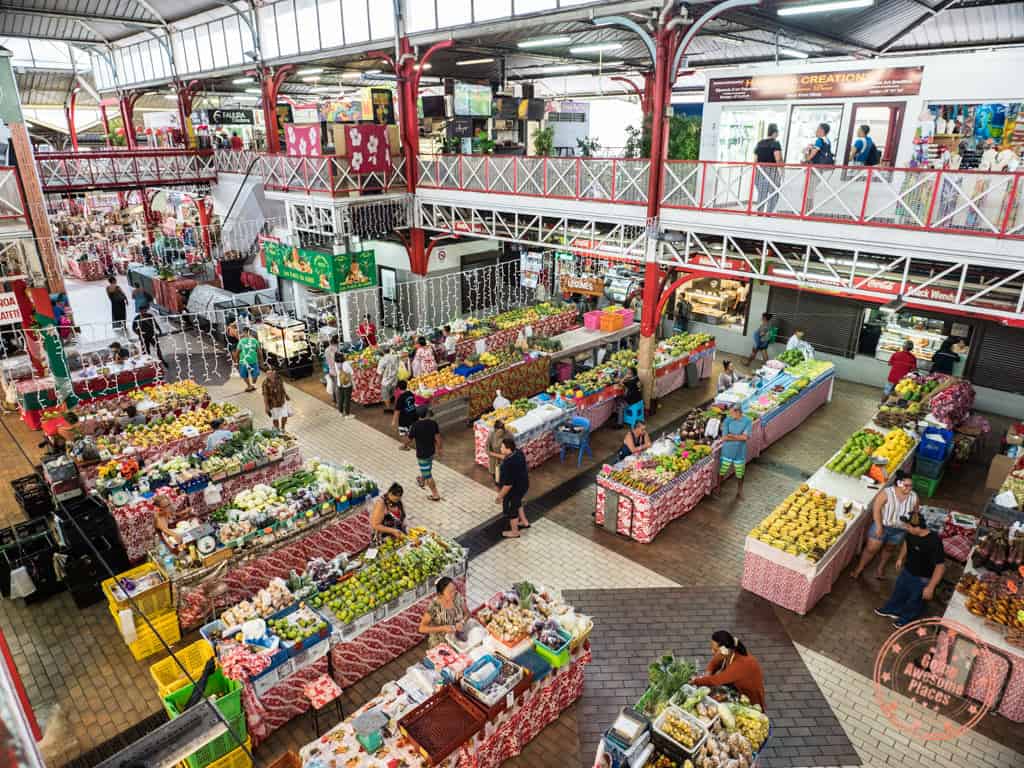
To further help you decide what islands to add to your wish list, I’ve put together a completely subjective and unscientific list of the top 10 islands you should visit in French Polynesia. For each one, I’ll explain my reasoning for the ranking.
- Bora Bora – Undeniably iconic and romantic and contrary to popular belief, can be done affordably. This is the place to go for the overwater bungalow experience.
- Rangiroa – You can have a comfortable resort experience, see the dolphin show, while doing arguably the best diving in French Polynesia.
- Huahine – One of Tahiti’s best kept secrets as a place where you can live like a local and get away from most “crowds”.
- Fakarava – A must-do for any scuba divers with incredibly biodiversity that is unmatched anywhere else.
- Raiatea – A mountainous island with opportunities for hiking, superb scuba diving, and
- Maupiti – You won’t find any resorts here but for anyone looking for an authentic Polynesian experience that ticks all of the boxes for island-aficionados while still staying in the Society archipelago, this one is highly rated.
- Tahiti – On the list because you have to fly through it and I think there’s value in going there to use as an orientation for French Polynesia and for stocking up on supplies.
- Moorea – While incredibly beautiful, I have a hard time recommending here if you’re already doing Bora Bora. That said, there’s an incredibly balance of the lush outdoors, underwater, and resort-life here.
- Tikehau – You could call this the perfect example of an atoll with an almost unbroken ring of continuous coral, resulting in a lagoon that resembles a giant swimming pool. You’ll also find great diving here along with a pink sand beach.
- Taha’a – This is a one-two punch because they share a lagoon with Raiatea. The soft mountains here are known for their vanilla farms. Come here for a slow-paced of island living. It is also home to the luxury Le Taha’a Resort and Spa.
So how do you choose and which is the “best”? Ultimately this is highly subjective but if you find that my style of travel is similar to yours, which for the newcomers means a blend of affordable luxury experiences and doses of outdoor adventure while also sprinkling in some off-the-beaten-path, you should head over to the 16 day itinerary of French Polynesia. This breaks down exactly how my own trip was executed and gives you an idea of where we stayed, what we did, where we ate, and how the logistics worked out.
Getting there

So let’s start off with transportation. How do you get into The Islands of Tahiti?
Fly
As an island nation, flying in is going to be your one and only way to get into the country.
Airports
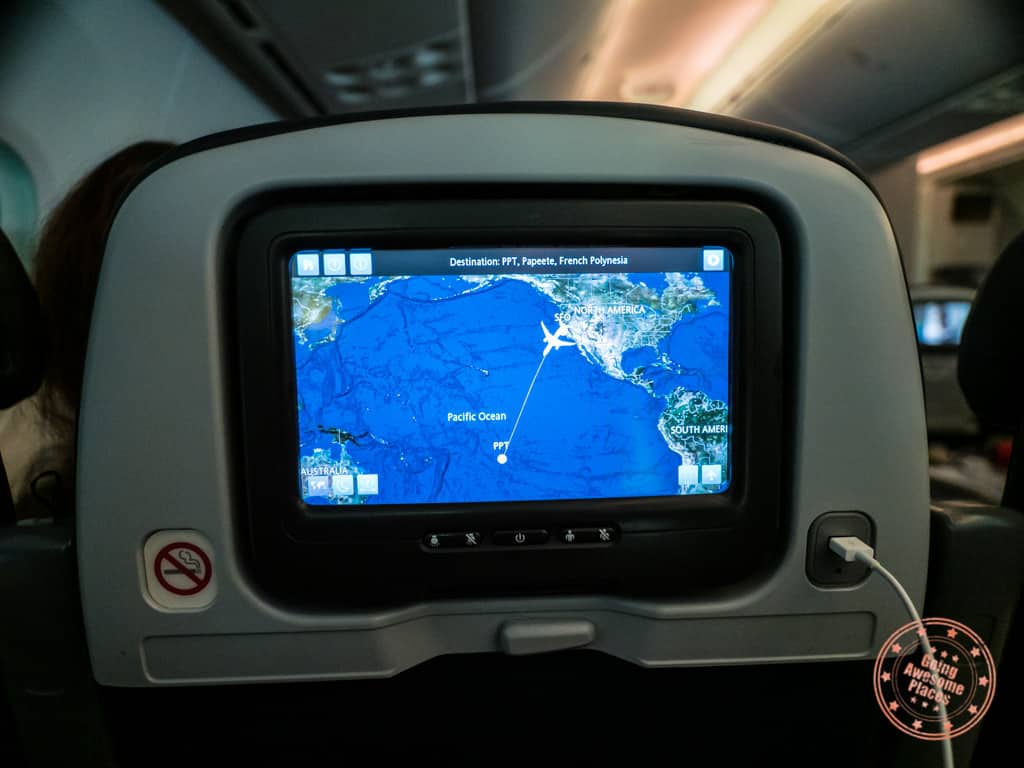
The international airport is located on the island of Tahiti. It’s name is Faa’a International Airport with code PPT which comes from the name of the capital, Papeete since it is located right adjacent to it on the island.
Which cities have direct flights to Tahiti?
- San Francisco – United Airlines
- Los Angeles – Air Tahiti Nui
- Paris – Air France, Air Tahiti Nui, and French Bee (all connect via Los Angeles)
- Auckland – Air New Zealand, Air Tahiti Nui
- Honolulu – Hawaiian Airlines
- Rarotonga, Cook Islands – Air Tahiti
- Nouméa, New Caledonia – Air Calin
- Santiago/Easter Island – LATAM Airlines Group
- Tokyo – Air Tahiti Nui
Of note on this list are French Bee which is a new low cost carrier from Paris and the new route from San Francisco with United Airlines which I took advantage of. The United Airlines route is a great new addition because it is the only Star Alliance partner that operates there from North America. Lastly, another route that is quite interesting is the Latam opportunity to route through South America (Chile specifically) and going through Easter Island. They only fly once a week but would make for quite the ambitious trip.
I recommend using the Skyscanner to find the best prices on flight tickets and be able to put alerts and trackers if you’re starting to plan early. The Skyscanner app is also super helpful.
Do I need a visa?
When it comes to visas, you almost have to treat French Polynesia as if you were entering France which is why there’s a special EU line at customs when you land in Tahiti. In all likelihood you will be visa-exempt but make sure you check out the exhaustive list of countries where this is the case. It will also be worthwhile to go through the entry rules for French Polynesia for anyone that needs more detailed guidance including their helpful checklist for short stays of less than 3 months.
Landing form
The immigration form and visitor forms are pretty standard but wanted to share with you what it looks like.
A few key points:
- If you’re from EU or Switzerland, you don’t need to fill it out.
- If you’re transiting to somewhere else such as Australia or New Zealand, you also don’t need to fill it out.
Getting between islands
Once you’re in the country, how do you get to other islands from Tahiti? Also, once you’re on an island, how do you get around?
Fly
With how geographically spread out the islands are, the easiest form of travel will be through flying. This is completely serviced by Air Tahiti if you don’t include the private charter airlines. They operate a fleet of 14 planes and effectively cover most of the country with the routes which you can see in the map below.
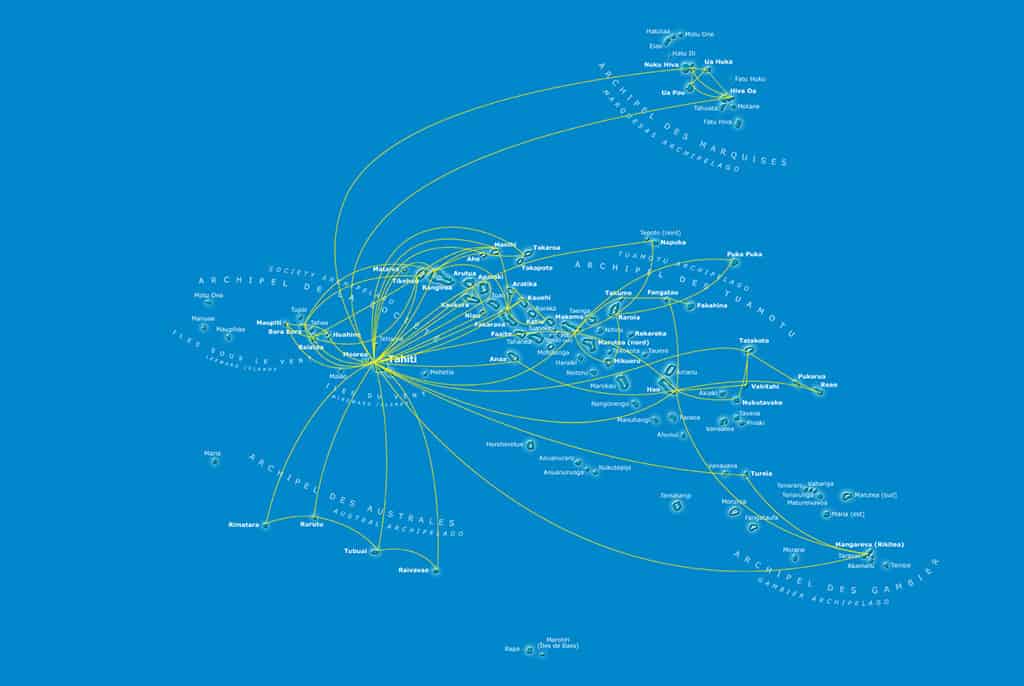
With the above, there should be a few questions you aren’t asking that need to be asked.
What makes Air Tahiti routing so challenging?
Looking at the route map, it looks like you can easily get anywhere but the truth is that once you dig deeper, it’s a bit more complex. Without making this too complicated, here are a few key things you need to be aware of when
- You can’t book Air Tahiti through a flight booking aggregator like Skyscanner or Kayak, you have to book directly.
- Many of Air Tahiti’s flights are loops so if you want to go to Maupiti there’s a stop in Huahine and this is how they’re able to service some of the smaller islands.
- Most flights routes and their loops are designed to only hop between islands within an archipelago.
- Flights between archipelagos almost always have to go through Tahiti. There are a few exceptions.
- Pay attention to the direction of travel. For instance, if you want to hop around the Society Islands, the flights move from Tahiti westward and once you make it to the end (i.e. Bora Bora), you then have to fly back to Tahiti. You can’t go backwards in this case.
- If you haven’t figured it out yet, all routes start and end in Tahiti and you can run into cases where you can’t connect two legs within the same day which forces you to stay a night in Tahiti.
How do you get from the Society Islands to the Tuamotu Islands?

This is a common situation for many that want to explore at least two of the archipelagos of French Polynesia. For me, this caused a lot of frustration because originally I wanted to do Bora Bora at the very end of the trip but later realized that this wasn’t possible unless I did an unnecessary connection through Tahiti.
The most efficient way to explore both archipelagos is through the Bora Bora to Tikehau or Rangiroa, or the Raiatea to Tikehau connector. What you need to know is that these only go one direction so you are physically not able to go from Tuamotu to Society Islands. If you’re adamant about going this direction, you have go through Tahiti’s PPT airport. This could mean you have to stay a night if the connection isn’t seamless and will definitely add to transit time.
Is there a way to save money with Air Tahiti?
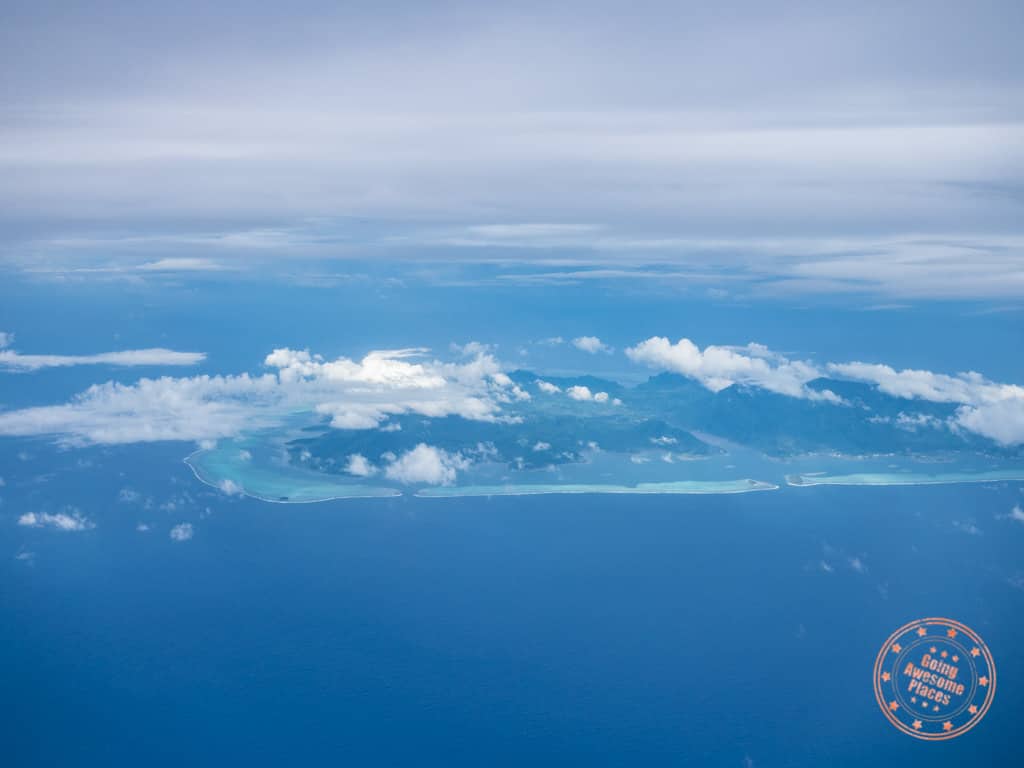
Inter-island flying is not cheap and adds up quickly so how do you keep costs low? One thing I suggest you take a look at are their multi-island passes. There are many to choose from and what they do is allow you to pay a single price and gives you access to all the islands on the pass. These passes are great for those that have a lot of time to work with and can hit up close to all of the islands on the pass.
Here are key rules to pay attention to:
- They do not sell passes to infants
- As a general rule, all passes start and finish in Tahiti or Moorea.
- You do not have to visit all of the islands included in your chosen Pass, but at least two islands must be visited.
- Each island may be visited only once and returning to Tahiti while using the Pass is not permitted (there are exceptions for the Lagoons Pass and when extensions are involved).
- All islands in one archipelago must be visited before moving onto the next one.
- Within a given archipelago, the islands may be visited in any order.
How do you book flights?
Generally everything can be done online through Air Tahiti but if the system spits out errors as it did for us, you’ll need to contact someone through their support service and handle everything through e-mail instead since most likely it’ll be difficult to call them directly.
In order to pay, they sent a secure link to my e-mail with the total amount and I was able to pay by credit card.
What is it like flying between islands?
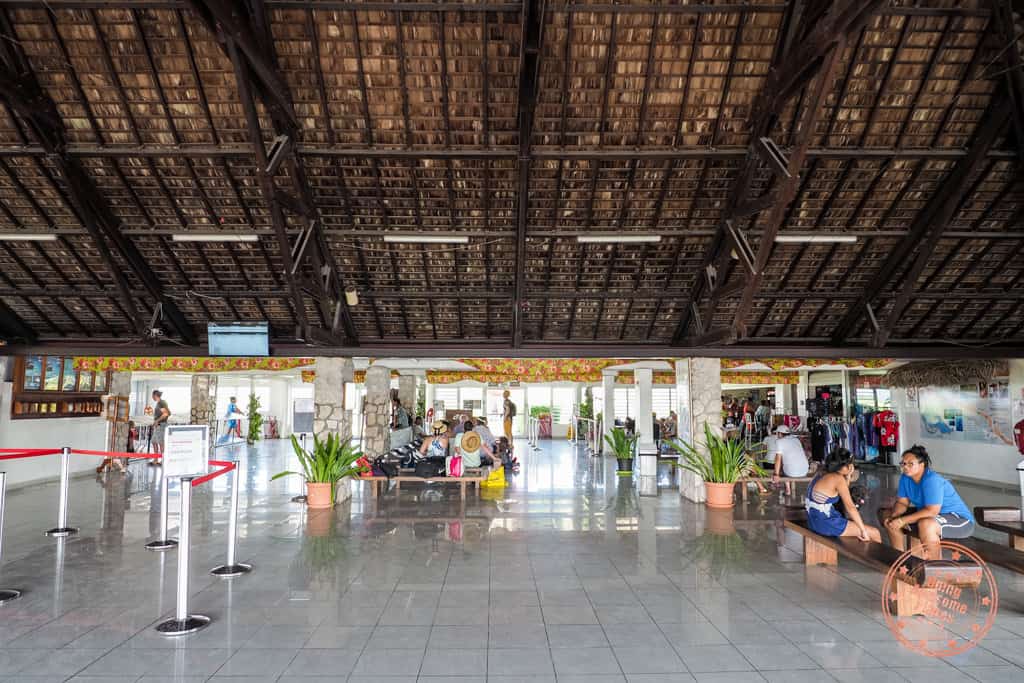
This may seem obvious but inter-island flights are domestic so you won’t need to go through security. Beyond this, there are a couple of other tips that aren’t really disclosed anywhere else.
Check-In
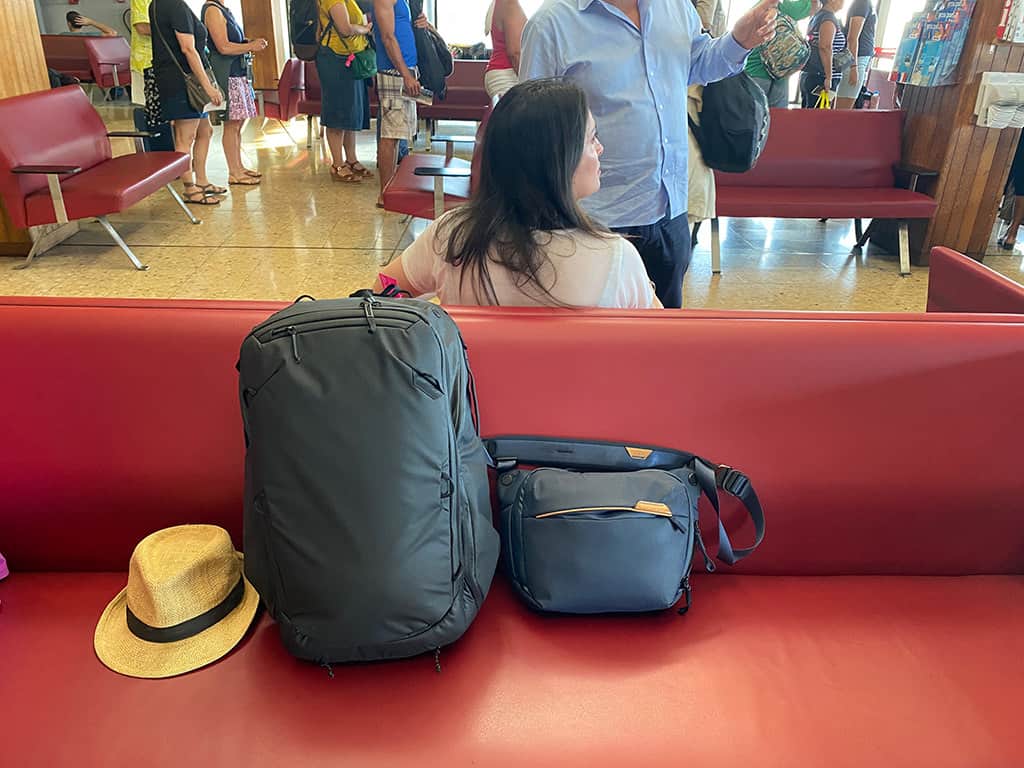
- Carry-on luggage – Limited to 5kg and one piece only.
- Tahiti – Extremely strict. They weighed the carry-on and make sure you only have one. Once approved, they’ll give you a pink tag to attach to your bag.
- Camera gear – In my case, I was well over weight but after I mentioned it was camera gear, they seemed to be ok with it. It’s hard to say whether this was agent-specific but this legitimate excuse seemed to work.
- Enforcement – At the gate, agents were actively patrolling and double-checking anyone that had carry-on that seemed too large or heavy.
- Bora Bora, Rangiroa, Fakarava – Not strict at all with carry-on luggage. They might’ve done a quick eye-check for the number of pieces but they did not weigh any.
- Other islands – I’d like to say they operate the same as the other islands I visited but I can’t say for sure.
- Tahiti – Extremely strict. They weighed the carry-on and make sure you only have one. Once approved, they’ll give you a pink tag to attach to your bag.
- No security means that you don’t have liquid restrictions so you can have bottles of water with you on the plane.
Flight
- Seats are comfortable and spacious with plenty of leg room and space for luggage under the seat in front. Overhead bins are small which is why they have strict limitations on size.
- Drink service is available for flights that originate or end in Tahiti or Moorea. Only cold drinks (juice) is available.
TIPS:
- For unobstructed views, sit in the first 3 rows or the rear 3 rows (see photo). Pay attention to clarity of the windows and look out for coloured marks if you want the best window seat.
- For carry-on bags, I was able to have my Travel Backpack and 6L Sling work because my sling was collapsible and I could just pull it out on the plane if I needed to.
Ferry
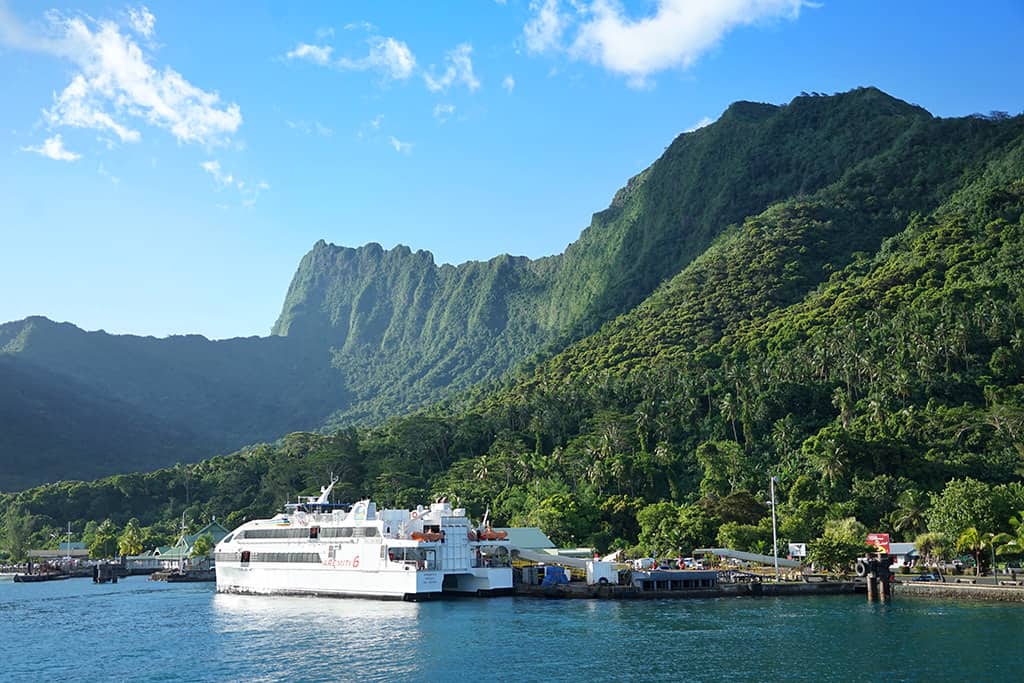
For islands or motu’s that are close to each other, there are local ferry services available but it’s not advisable because it’s very long and not comfortable since they’re operated by what’s essentially cargo ships. You can use these ferries to get from Tahiti to other Society Islands (Raiatea, Taha’a, and Huahine). To give you an idea of time, it takes 9 hours to get from Papeete to Huaahine and 13 hours to get to Bora Bora.
This option is great for those that have lots of time to work with and don’t mind roughing it in order to save money. There are two services per week.
There is also ferry service between the islands of Bora Bora, Raiatea, Taha’a and Maupiti. This is operated by aa 140-passenger high-speed boat, Maupiti Express II, and it runs on a loop three times a week.
Lastly, there’s a well-known service to go between Tahiti and Moorea which are very close to each other. This ferry is only 30-40 minutes and this one actually makes a lot of sense because it’s quite scenic, much cheaper, comfortable, and has frequent service.
There are several companies that service this route. One is Aremiti and the other is Terevau. Aremiti boards operate from the dock on Motu Una which is an island that is connected to Papeete. Terevau boats depart from a maritime station right in the heart of Papeete. Both of them pull into the dock in Vaiare on the northeast side of the island. Each company has 6-7 trips a day (5 on Sunday).
Cruise ship
An alternative way to see French Polynesia is through a cruise ship. While you won’t be able to spend as much time on land, this is a great way to see many islands in one trip and is a popular way to see the Marquesas as well.
The two main cruise companies that do this route are Paul Gauguin and Aranui 5.
Paul Gauguin is a 5-star, 332-passenger cruise ship that’s all-inclusive and has itineraries ranging from 7 to 14 days, covering the Society Islands, Tuamotu Islands, and also other countries such as Cook Islands and Fiji.
Aranui 5 runs an all-inclusive 14-day trip from Papeete to the Marquesas Islands with their custom-built dual-purpose passenger/freighter. They also have a new route that goes out to Pitcairn Island which is part of the Gambier Islands.
There are also larger cruise ships that go to French Polynesia including Holland America and Princess Cruises.
Moving within an island
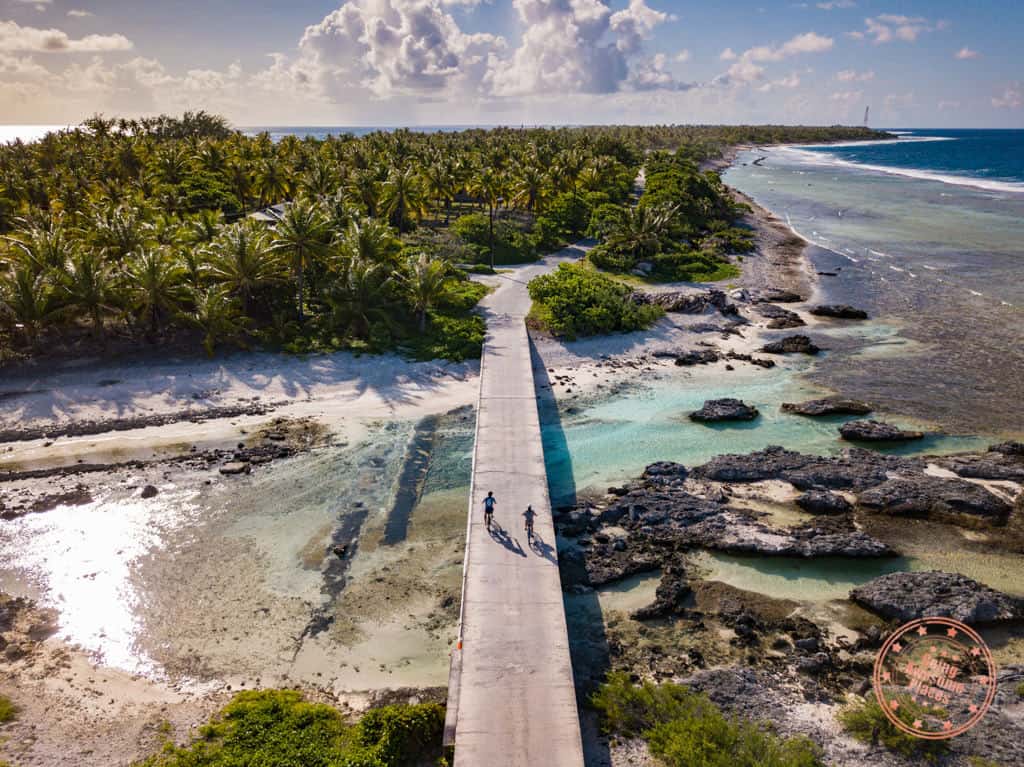
Once you’re on an island, there are a number of ways around but it will depend on what island it is.
Car rental
On many islands including some of the smaller ones such as Rangiroa, it’s possible to rent a car but unlike travel in other countries, it doesn’t make sense in most cases while also being almost necessary in others. Here’s what you need to know.
- Main international companies to book with are Avis, Hertz, and Europcar. Their depots are usually located at the airport, and/or ferry quay or both. Pay attention to whether your rental includes kilometers or not (i.e. Hertz).
- The secret though is that there are local car rental companies, Ecocar and Easycar, that service Tahiti and they have very competitive rates.
- You need to have a car while you’re in Tahiti if you’re planning on being there a couple of days especially if you’re not in the city of Papeete. Taxi’s are expensive here and the island is much larger than most people realize. The only exception is if you’re planning on leveraging excursions while you’re there and/or you’re staying at a resort where there’s no need or interest to go outside. Another thing to think about is the cost of round-trip airport transfers and whether a car rental would still be cheaper. This applies to Moorea as well.
- You do not require an international’s driver’s license here. Your driver’s license from home is enough.
For the big companies, make sure you head over to the best car rental coupon codes to make sure you maximize on savings.
Ferry
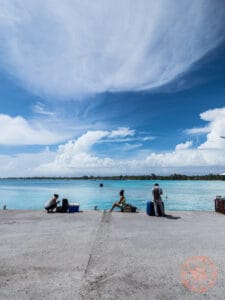
Ferry service is going to be critical especially for islands such as Bora Bora where there’s a main island in the middle accompanied by an outer motu ring. Alternatively, atoll’s also require boat ferries if the airport is on one motu but you’re staying on a different motu.
Here are a few examples that we encountered:
- Bora Bora property ferry – 12,390 XPF per person for the round trip
- Bora Bora ferry to Vaitape – 3,045 XPF per person for the round trip
- Rangiroa ferry from Avatoru to Tiputa – 300 XPF per person each direction
- Shuttle between Bora Bora sister properties (i.e. Le Meridien and St. Regis) – Free with restaurant booking
Taxi/Shuttle
- Proper taxi service really only exists on Moorea and Tahiti.
- Beyond actual taxi’s, most islands have transfer/shuttle services which are in essence the same thing. We ended up using Fetia-Ura Vahine for both our tours and transfers in Tahiti. For other taxi and shuttle services, take a look here for recommendations.
- For the most part it seems like meters aren’t used and all companies charge a fixed rate.
- Examples:
- From the Puna’auia part of Tahiti, it will typically cost 1,500 to 2,000 XPF each way to Papeete.
- If suitcases are involved, it’s 200 XPF per piece.
TIP: Many restaurants offer free shuttle service so it doesn’t hurt to ask.
Public Transportation
To a certain extent, public transit exists on all islands but for any that you’d realistically take, you’d be looking at Moorea and Tahiti.
Public buses are known as Le Truck and are a cheap way to get around. On Tahiti and Moorea, buses either run in clockwise or counterclockwise location. The central station on Tahiti is in downtown Papeete while in Moorea it’s at the ferry port. Buses will have their route number and final destination marked. Around the island there are bus stops but if you’re in a remote area, you can always hail it and they will usually stop.
The most handy route in Tahiti is the one that runs between Papeete and Faa’a International Airport.
On Tahiti, buses cost 200 XPF near the Papeete area however fares do go up as you get further away (up to 600 XPF). Children and students are half price.
The main problem with these buses are that 1) the schedule is unreliable (weekends are very infrequent) and 2) they shut down at 5 to 5:30PM. Ultimately, it’s not a method of transportation of choice if you’re on a schedule and definitely not if you plan on any evening activities.
Bicycle
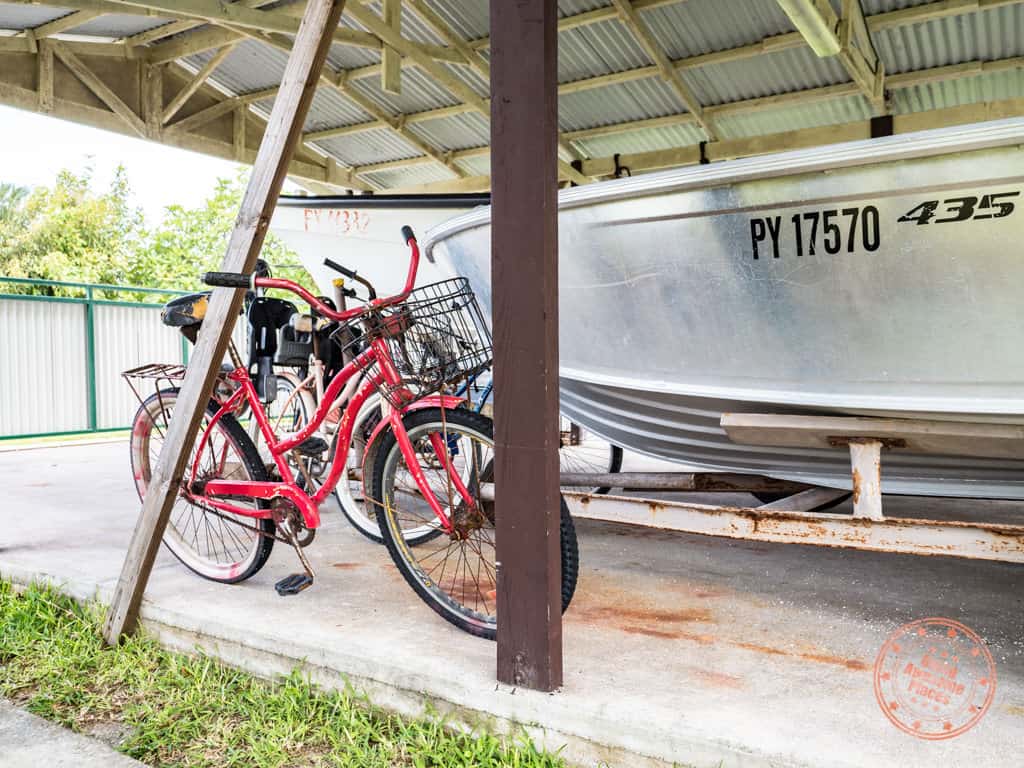
The best way to get around is perhaps the simplest. The joys of being on the smaller islands of French Polynesia is that you can easily hop on a bike and ride around whether for fun or to pick up supplies that you need.
When picking your accommodations, it may not be one of your first priorities but it turned out to be quite important to have free bike rentals. This was sorely missed when we got to Pension Paparara in Fakarava because it became really difficult to go out on our own to explore.
Health and safety
French Polynesia is as safe as countries come. Here’s why. With the exception of Tahiti, all islands are very small with a tiny population to match them. From my conversation with a local, the reality is that everyone knows everyone else on the island. As a result, crime rate is very low and for travellers is very safe to walk around whether day or not.
In terms of other aspects of travel safety, here are a few other points to take note of:
- Water – Locals do drink from the tap but we were advised to either drink bottled water or drink tap water that has been boiled.
- Uncooked vegetables – No issues here.
- Natural dangers – Cyclone season is between November and April which corresponds to rainy season. In talking to locals, there hasn’t been a major cyclone in a long time but that doesn’t mean that it won’t happen. Stay up to date with tropical storms and cyclones by checking weather forecasts. When it comes to dangers under water, be smart and wear the appropriate footwear when heading into the water as there is a lot of sharp coral (check my French Polynesia packing list). Be careful around coral as well for moray eels that will bite. Sharks and rays in the lagoon are not aggressive so no need to panic if you encounter them.
Mosquito protection
This is a perfect segue to what you can do to reduce bites on The Islands of Tahiti. From personal experience, mosquito’s aren’t a serious problem in overwater bungalows during our stay at Le Meridien Bora Bora. However, the same cannot be said for Tahitian guesthouse stays on islands such as Rangiroa and Fakarava. Of course, this will vary property to property and will be related to variables such as whether it’s rainy season or whether there is standing water nearby.
I recommend that you buy mosquito repellant before you leave home but if you’re looking for something local, find a pharmacy in Tahiti and look out for Moustidose which we found quite effective. It’s a product of France and does not have deet.
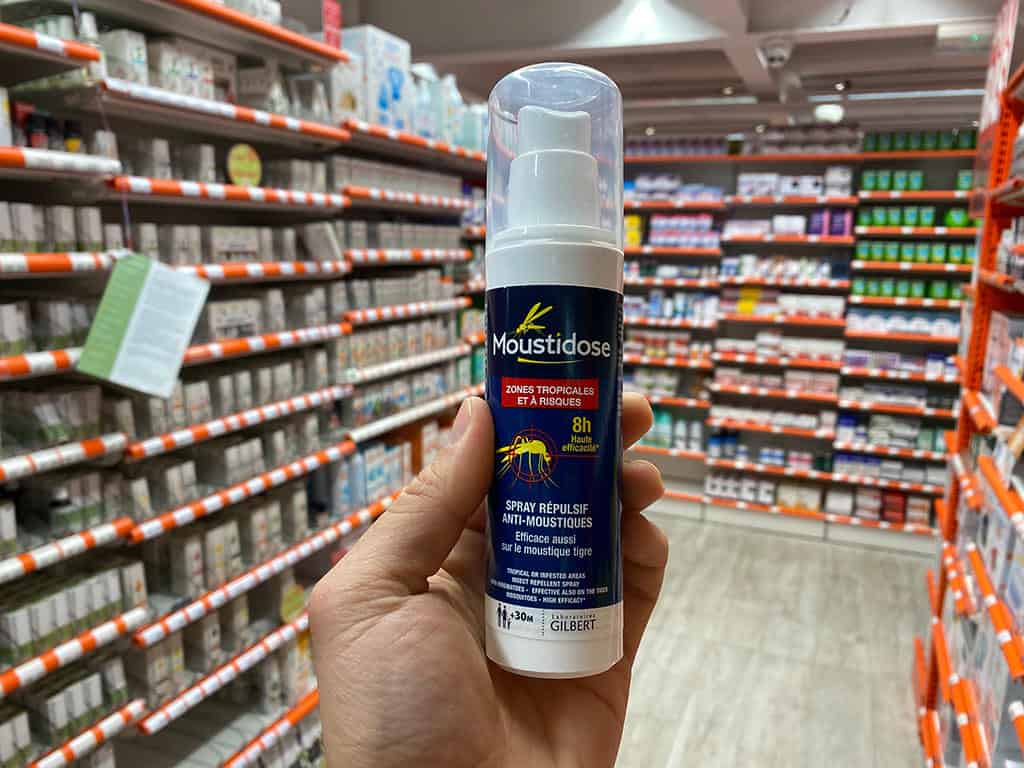
If mosquito nets are included in your accommodations, there’s probably a good reason for it. Here are a few tips that’ll make sure you use it properly:
- When setting up the net, make sure to tuck it under the mattress. This is an important step because if you don’t, mosquito’s can come up from any gaps on the ground.
- Especially with circular nets, pull it tight at the edges of the bed to give you as much space inside as possible. Otherwise you’ll feel like you need to sleep it fetal position.
- When sleeping, make sure your head, feet, and arms aren’t touching the net. If it’s not too hot, bed sheets can help here.
- When entering or exiting the mosquito net, make sure you have your headlamp/flashlight turned off. Also, pat the net before entering/exiting to make sure there are no mosquito’s nearby.
- Inspect the net for holes and plug them with something like scrunched up toilet paper
- Before sleeping, turn on your headlamp/flashlight and inspect the inside of the net to make sure none got in somehow.
- Bring mosquito repellant and toilet paper into the bed in case especially if you’re not good at catching them in flight with your hands. I found that one way to kill them inside the net is to spray them directly while they are resting on the net and then killing them with toilet paper after they are stunned and land on the mattress.
Travel insurance
I highly recommend getting travel insurance for a trip like this, not because it’s dangerous, but because you never know.
In the case something does go wrong, expenses will rack up very quickly when you factor in the fact that there is only one hospital on Tahiti and medical evacuations easily cost $10,000 or more.
Don’t cheap out. Get travel insurance and make sure you get a policy that covers your needs (especially if you scuba dive or plan on doing any extreme sports). From my experience, most policies cover scuba diving if you are certified.
If you’re in Canada, check RATESDOTCA to make sure you get the best rates. If you’re anywhere else in the world including the United States, World Nomads is worth getting a quote from.
Language
What you have to remember is that French is the primary language alongside Tahitian that’s spoken in The Islands of Tahiti. Therefore, it shouldn’t surprise you that once you go outside the comforts of a resort, and tourism-related services, English isn’t going to carry you that far.
Drawing from my experiences in Rangiroa and Fakarava, we really struggled to communicate with anyone that only spoke French. In these situations, you just have to do your best by pulling whatever knowledge of French you might have, figure out what English words the other person understands, and throw in a bit of charades as well. If that fails, you can always pull out the Google Translate app which is precisely what we did with our hosts at Pension Paparara. We also had some challenges at Snack Reimanutea in Rangiroa but luckily there were a few other travellers there that could help translate for us.
If you don’t read or speak French, it’s not a problem but come here with an open-mind when speaking with locals and communicate in a respectful way if you come across this language barrier.
Food you need to try before you leave
There are a couple of must-try dishes when you’re in French Polynesia. These are traditional Tahitian dishes that you’ll find almost everywhere. What I really loved about our meals on The Islands of Tahiti was just how fresh and well-balanced they are. I came back from my trip feeling healthier than ever because of how much fish and vegetables I had.
Poisson cru
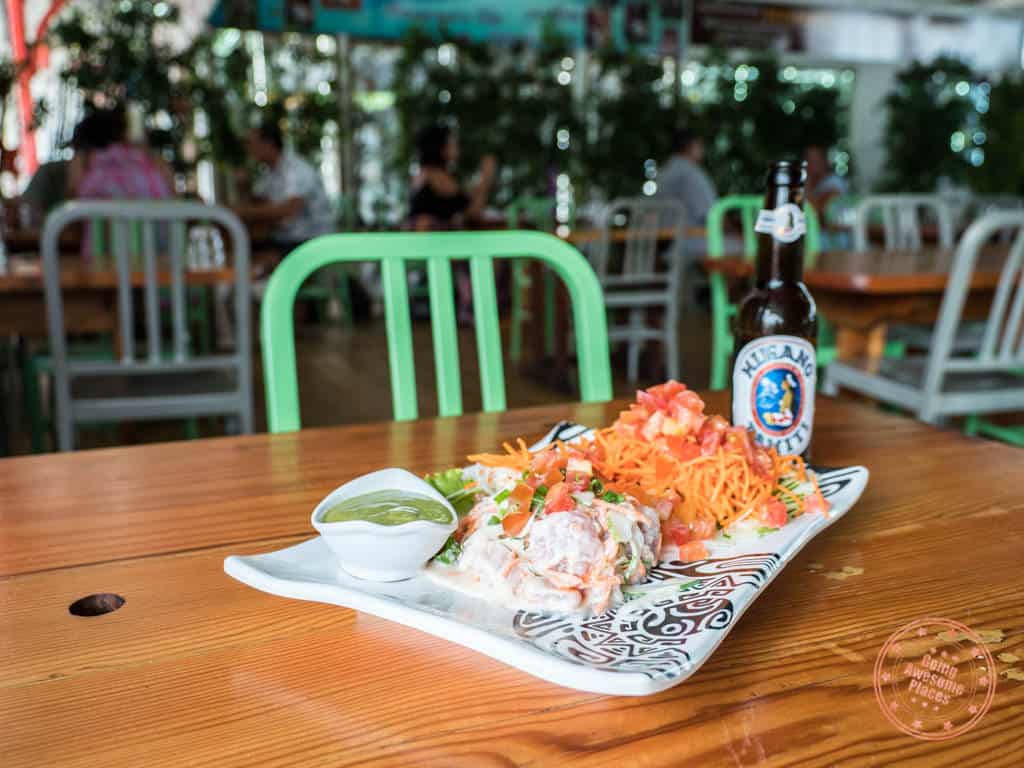
This is French Polynesia’s signature dish. It’s sweet, refreshing, and exotic. It consists of raw tuna marinated in lime juice and mixed with a blend of diced vegetables and coconut milk. It is typically served with a bed of rice. In many ways it’s similar to ceviche where the acidity of the lime also cooks the fish just slightly.
You can find this on almost every menu but the best place to have it is in restaurants like Cafe Maeva in Papeete.
Chaud froid de thon

This literally translates to “hot cold tuna” and when we first saw this on a menu we gave it a puzzled look but then realized that this is seared tuna. It can be prepared in many ways but it’s the combination of fresh tuna, perfectly seared on the outside, topped with sesame, and served with rice or fries, and a bowl of thick soy-based sauce.
Carpaccio
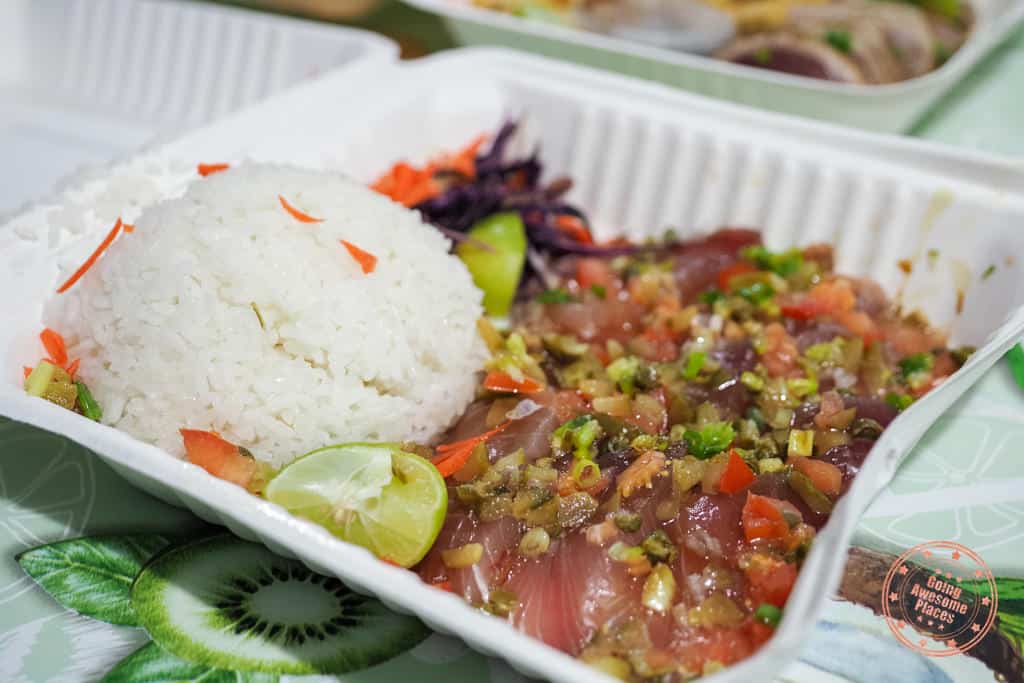
This dish features thinly sliced tuna but what really makes it special are the sauces they use. Even from the little snack bar on Rangiroa, we were blown away by their mix of soy, capers, tomatoes, and green onions.
Any grilled fish
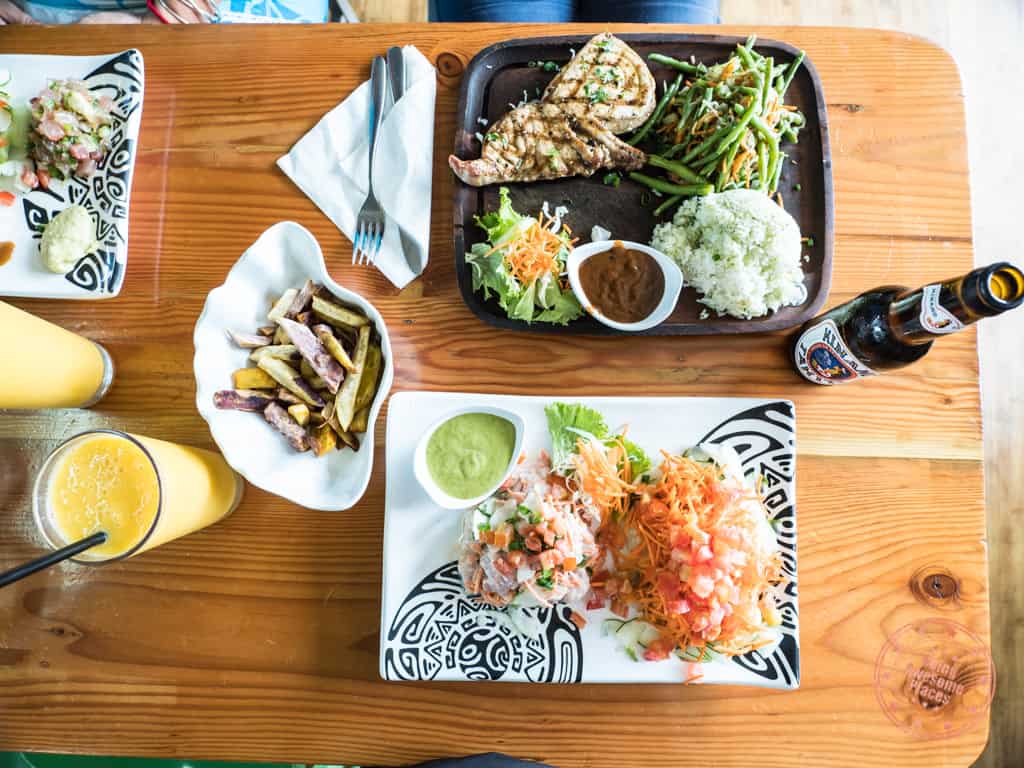
If you haven’t figured it out yet, there’s a wealth of fish and everything is freshly caught. For those that aren’t fans of raw fish, most restaurants will also serve grilled catches of the day and these will always be incredible.
Connectivity
There are 4 ways you can stay connected on your trip to The Islands of Tahiti.
As you look through the options below, you’ll naturally come to the question of whether you need to purchase data access or not. Personally, I found that free wifi coverage was so good that for 90% of cases, I was fine. For the 10% of cases where we were walking on the streets of Papeete and needed to use Google Maps or when we needed to do an on-the-fly Google Translate, it was definitely handy to have the wifi hotspot on so we always had internet coverage everywhere we went.
Where we found internet connectivity to be severely limited was in Fakarava when Tahiti Wifi stopped working and Pension Paparara only offered wifi in their lounge area and not at the bungalows by the beach.
Roam with home data plan
If you have a data plan from your home country, you can choose to enable international roaming. However, one thing you will need to be aware of is that you may not get coverage on the islands once you leave Tahiti.
From personal experience, I could not connect to any signal once we left the main island so I would not recommend this option.
Wifi hotspot
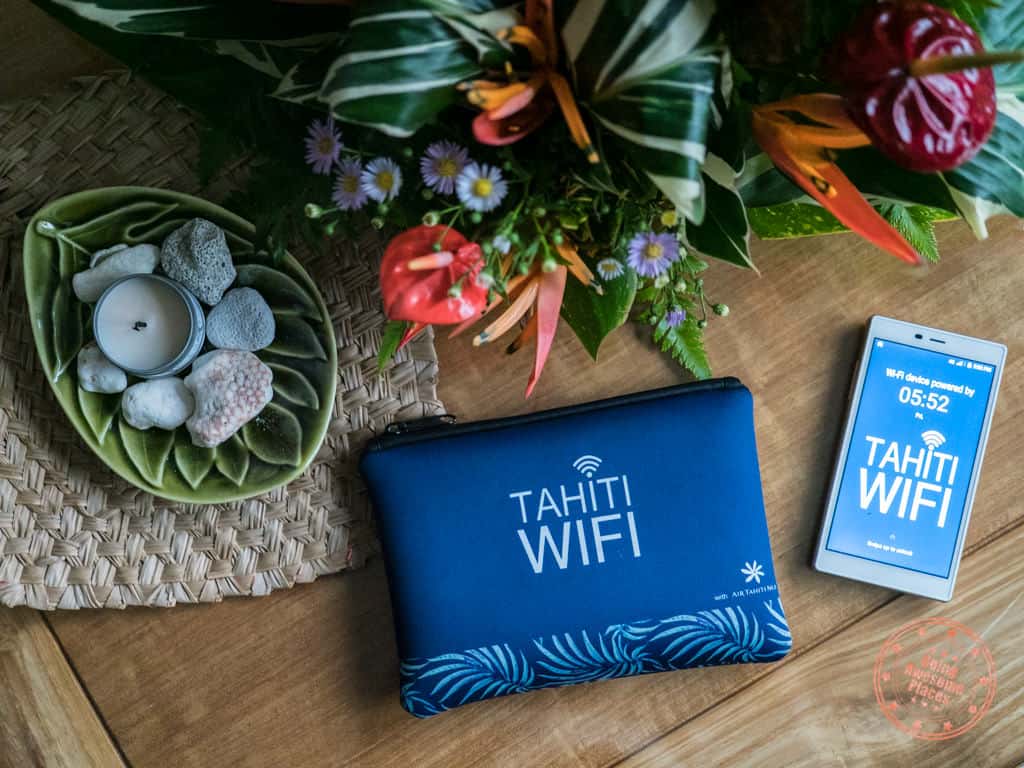
There’s one main company that has wifi hotspot rental services and that’s Tahiti Wifi. They have a very convenient booth at Faa’a International Airport connected to the car rental companies and the idea is that you pick up your unit once you arrive and you return it at the end of your trip.
Their pricing structure is pretty simple and comes with an Android-based hotspot that’s a simplified smartphone with a touchscreen.
- 7.90 EUR/day – 1GB per day and then throttled to 512 kbps afterwards
- 24.90 EUR/day – Unlimited high speed 4G/3G
- 49.90 EUR – 5GB for 30 days
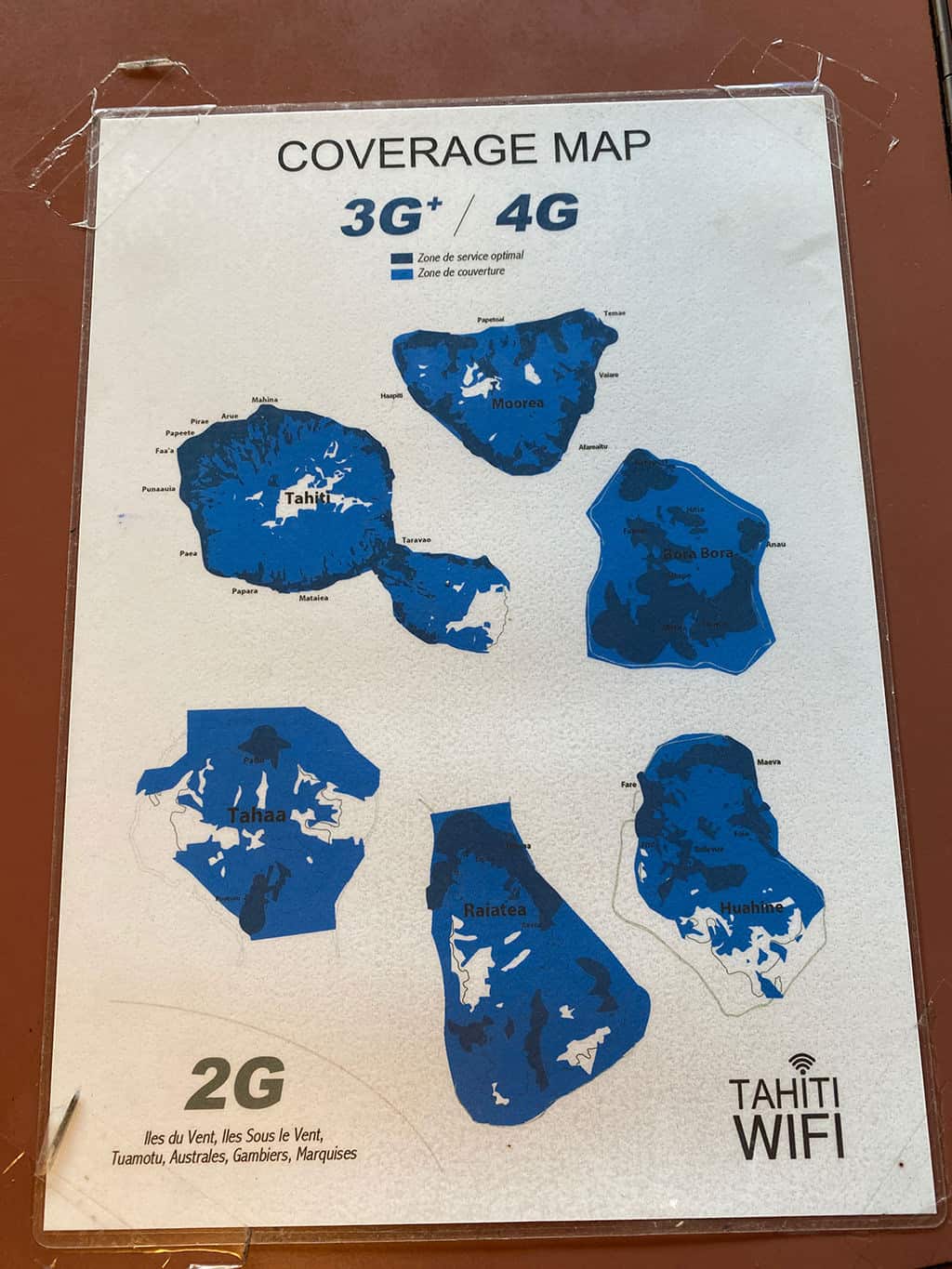
Something you need to take into consideration is their coverage map. All of the islands here (all Society Islands) has solid 4G connection down to 3G. All other Society Islands and archipelagos have 2G or no coverage at all. For our islands of Tahiti itinerary, there was coverage in Rangiroa but nothing in Fakarava. I spoke to the Tahiti Wifi staff about this and they said they are adding Fakarava later in 2020.
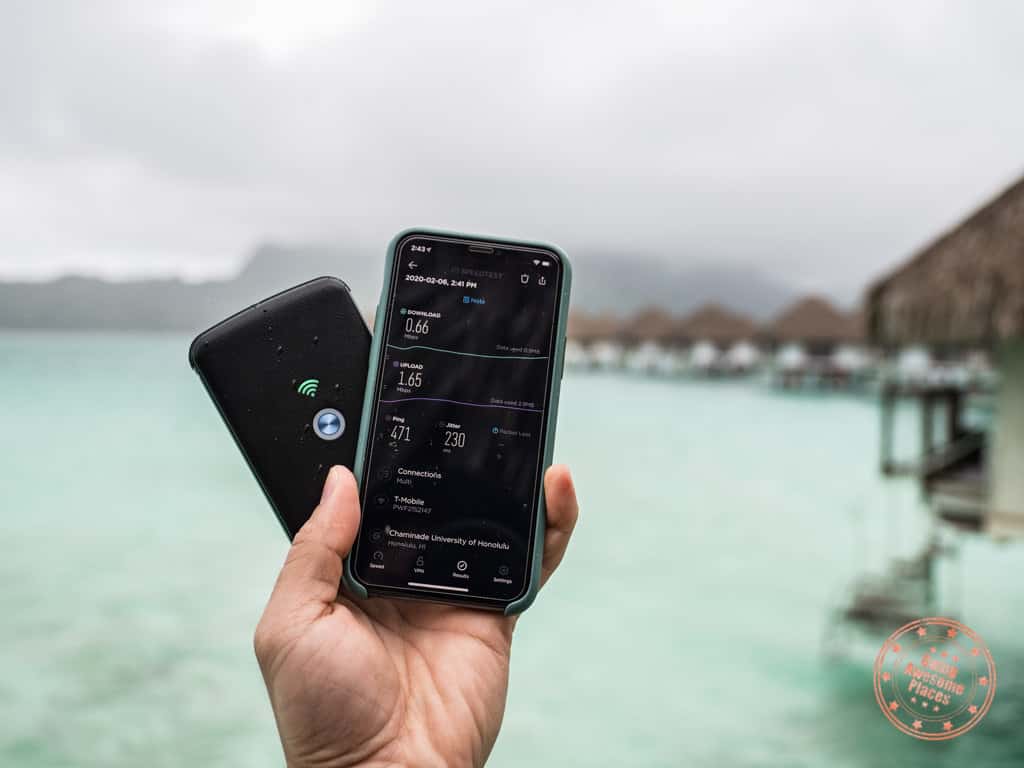
If you already have a hotspot device or are looking to get one, PokeFi has service in French Polynesia for highly competitive rates. You purchase their device and top it up with a data package. For instance, 5GB of data is $15 USD. This is slightly more expensive than Tahiti Wifi but may be worth it for the convenience of being ready once you land and not having to deal with device drop off.
PokeFi

Use the code GAP23200 to get $200 HKD or $25 USD off the starter package which comes with an extra battery
During my testing, I did however notice that their speeds were mostly in the 2G range so keep that in mind. Also, there was little to no coverage outside of Tahiti and Bora Bora.
Local SIM card
For those that prefer swapping SIM cards, there are options for you here. Tahiti Wifi is a reseller of Vodafone SIM cards and you can actually reserve cards on this site but there’s no real need. Their rates are:
- 5GB, 30 minutes local calling, 30 minutes international calling – 5,000 XPF
Vini is another cellular provider and there are other booths that sell their SIM cards. The Vini international visitor packages are:
- 3GB, 30 minutes local calling – 4,000 XPF
- 10GB, 30 minutes local calling – 8,000 XPF
When you compare these rates with the Tahiti Wifi hotspot it is almost identical or slightly cheaper but an advantage of the hotspot to the SIM is that you can share it with others that you’re travelling with.
Hotel wifi
Perhaps the most important of all is that every single resort, hotel, apartment rental, and Tahitian guesthouse are going to have free wifi. Knowing this, all of the above options may be a moot point if you plan on staying at the property for a majority of the day. This means that you’ll never need to use your SIM card data or hotspot.

Of course, signal coverage and speed will of course vary wildly from place to place so you can’t rely on it 100% but if you’re the type of person that just needs to check e-mails a few times a day, and update the news, you might not need to buy any additional access.
The good news though is that Le Meridien Bora Bora had incredible speeds and coverage throughout the entire resort. Whether in the overwater bungalow or on the beach, the wifi was very good.
Money
A trip to The Islands of Tahiti will be a delicate balance of credit card and cash spend. It’s not as easy as you think and will require some strategizing. Here’s what you need to know.
The local currency in French Polynesia is the Pacific franc or XPF. Banknotes come in denominations of 500, 5000, 1000, and 10000 francs. Coins come in 1, 2, 5, 10. 20, 50, and 100 francs. When you first see the bills, you’ll have the feeling that something about them is familiar and that’s because they use the same colours as the Euro which France uses.
While many places accept credit card in the country, it is still important to have cash on you. For instance, some Tahitian guesthouses only take cash and these are usually large sums of money. Ferries, shops, and restaurants can also be cash-only. Advanced preparation is required here because there aren’t exactly ATM and exchange centres everywhere.
How much XPF should you exchange?
This’ll really depend on what your trip itinerary looks like. My recommendation is to tally up all of your known costs that will be cash-only such as the remaining balance on a Tahitian guesthouse, shuttle transfer, ferry, etc. Once you have that fixed figure, add another 15,000 to 20,000 XPF per person.
Where can you exchange for XPF?
Money Changers
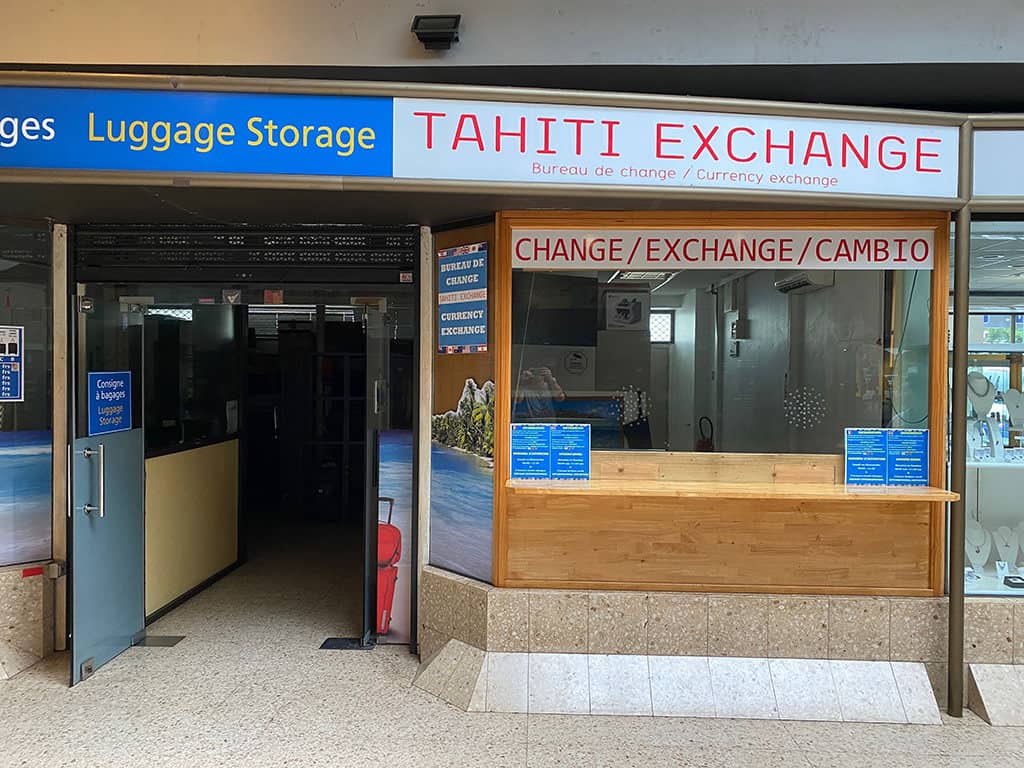
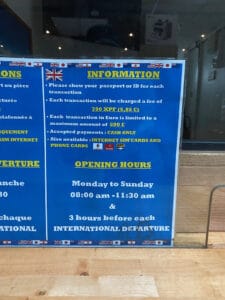
The most convenient place to exchange money is at the airport in Tahiti. They have the best hours as they open on weekends as well (Monday to Sunday 8:30AM- 11:30AM and 3 hours before each international departure) but they do charge a 700 XPF transaction fee. Their maximum transaction is also 500 EUR. The rate here is reasonable so you don’t need to worry about being scammed.
There are money changers in Papeete as well but this is only convenient if you’re staying downtown.
Bank
This was not easy to do surprisingly. Yes, banks can exchange money however not all of them have this capability. For example, we went to a Banque de Polynesia near our apartment but we found out that they don’t carry cash. Instead, we needed to find one of their central banks in Papeete.
Another disadvantage of changing money at the bank is that they don’t operate on the weekends so if you happen to be in Tahiti on Saturday or Sunday, you’re out of luck.
ATM
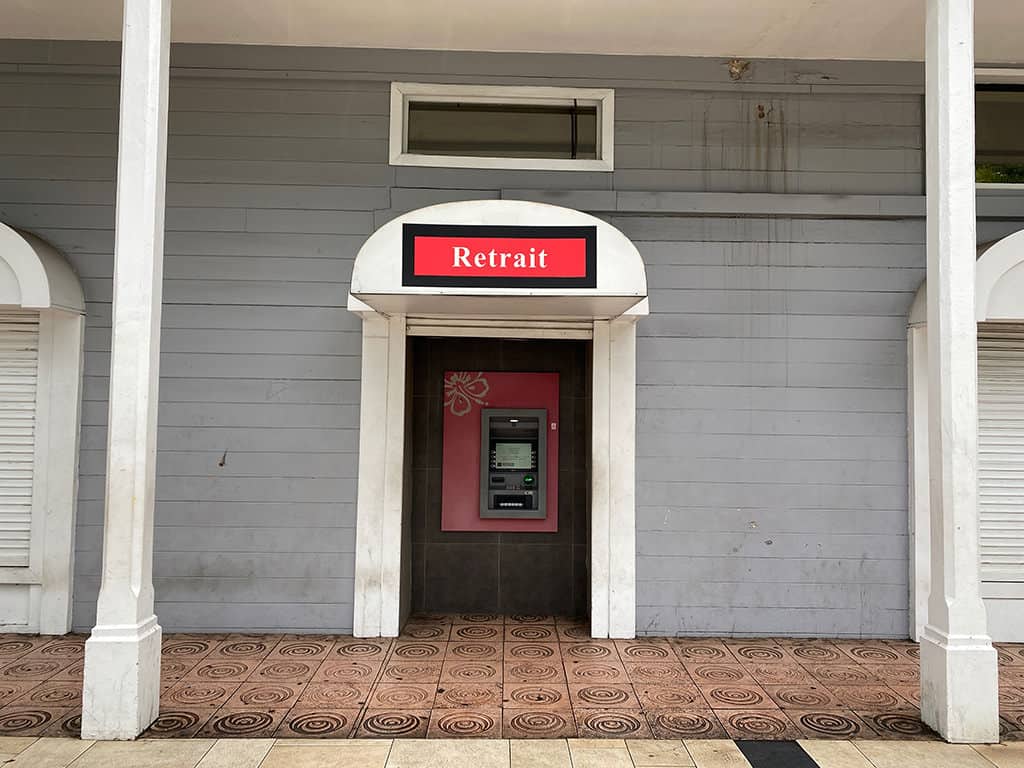
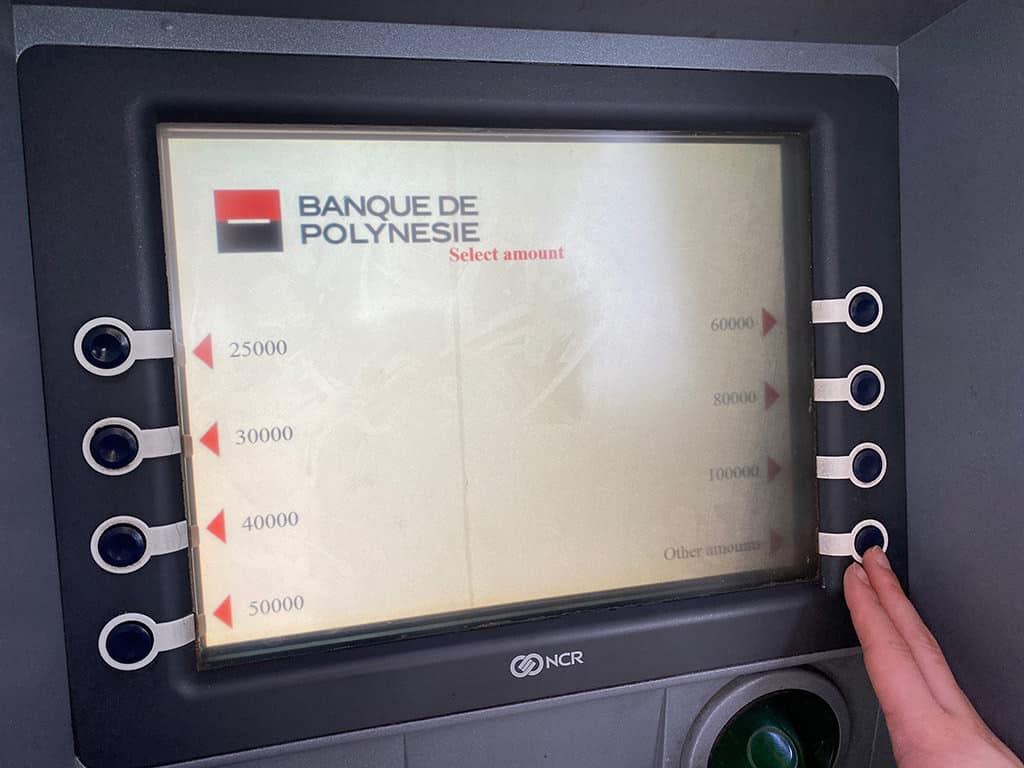

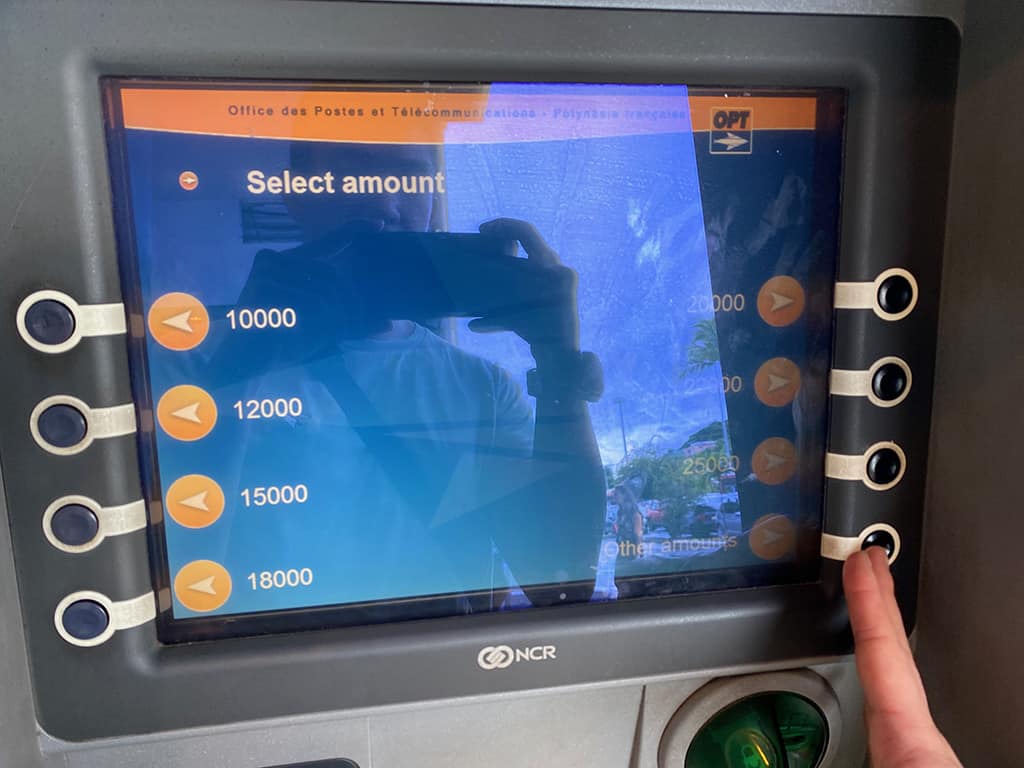

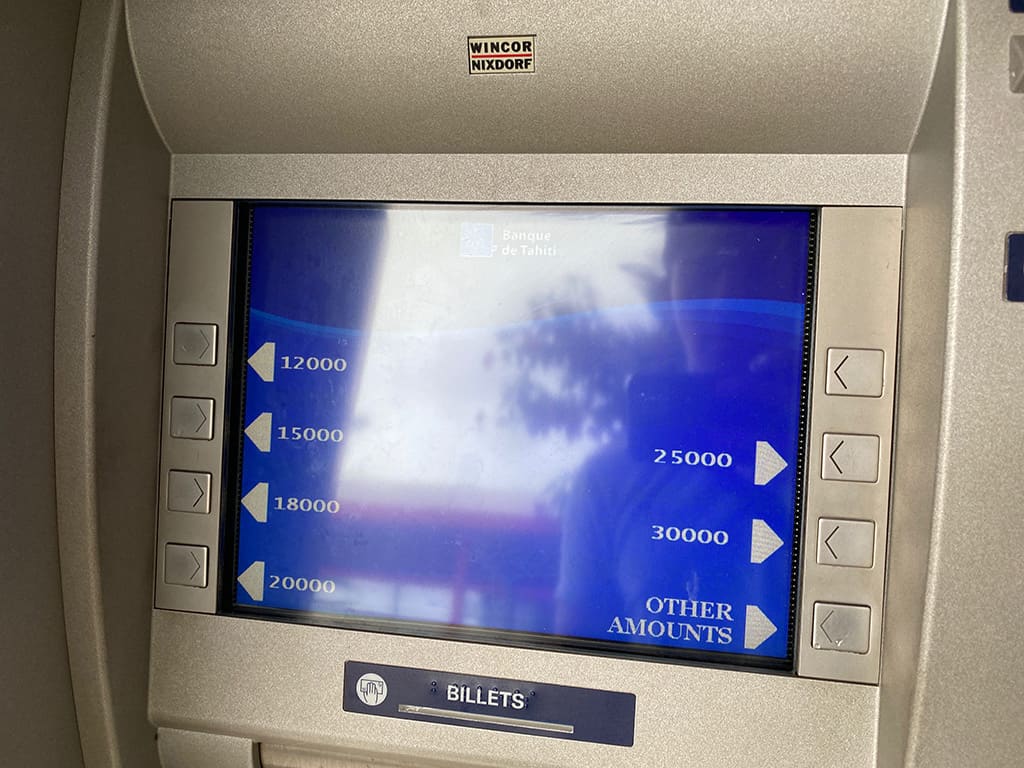
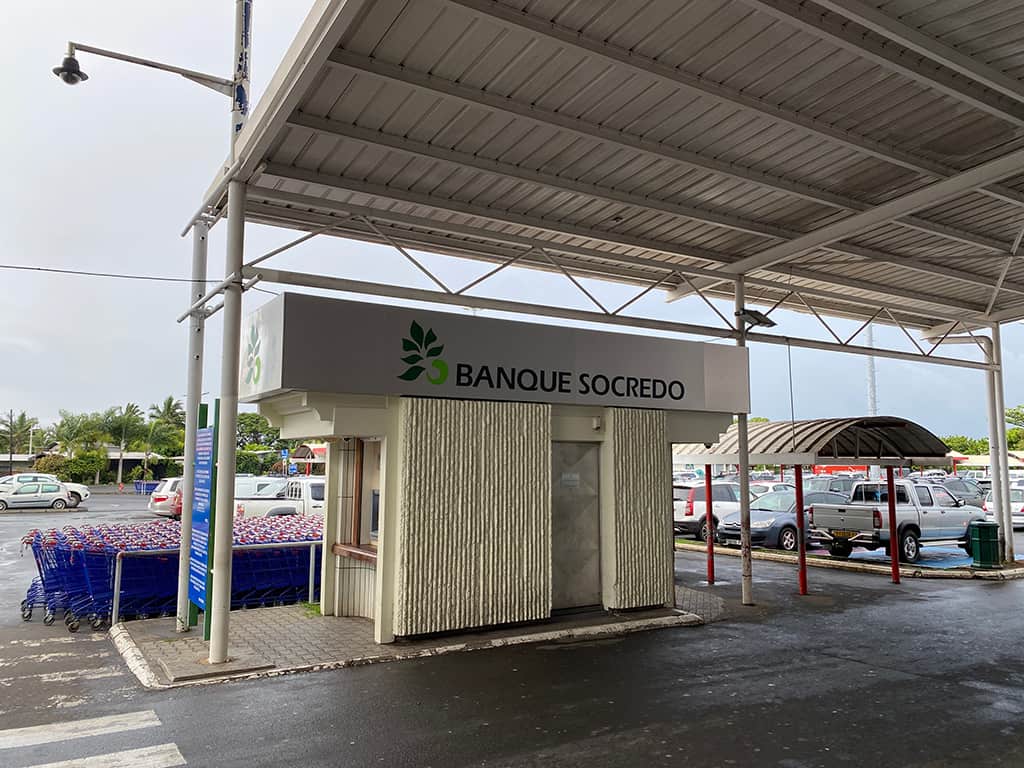
If you’ve missed your chance changing money in Tahiti or using the bank, your last solution is going to be the ATM.
ATM’s here can be picky when it comes to debit cards but from my experience my Canadian debit card didn’t have any issues with Banque de Polynesia, Office des Postes et Télécommunications or Banque de Tahiti. Banque Socredo is also easy to use.
ATM’s here do not charge a withdrawal fee which is good but one thing to note is that they do have withdrawal limits and each bank/machine is different.
- Office des Postes et Télécommunications – 25,000 XPF
- Banque de Tahiti – 30,000 XPF
- Banque de Polynesia – 100,000 XPF
Where are credit cards accepted?
Every proper establishment should take credit card. You’ll be surprised how many do take them. As an example, even one of the small convenient stores in Rangiroa accepted credit card when I didn’t expect it.
How do you save money?
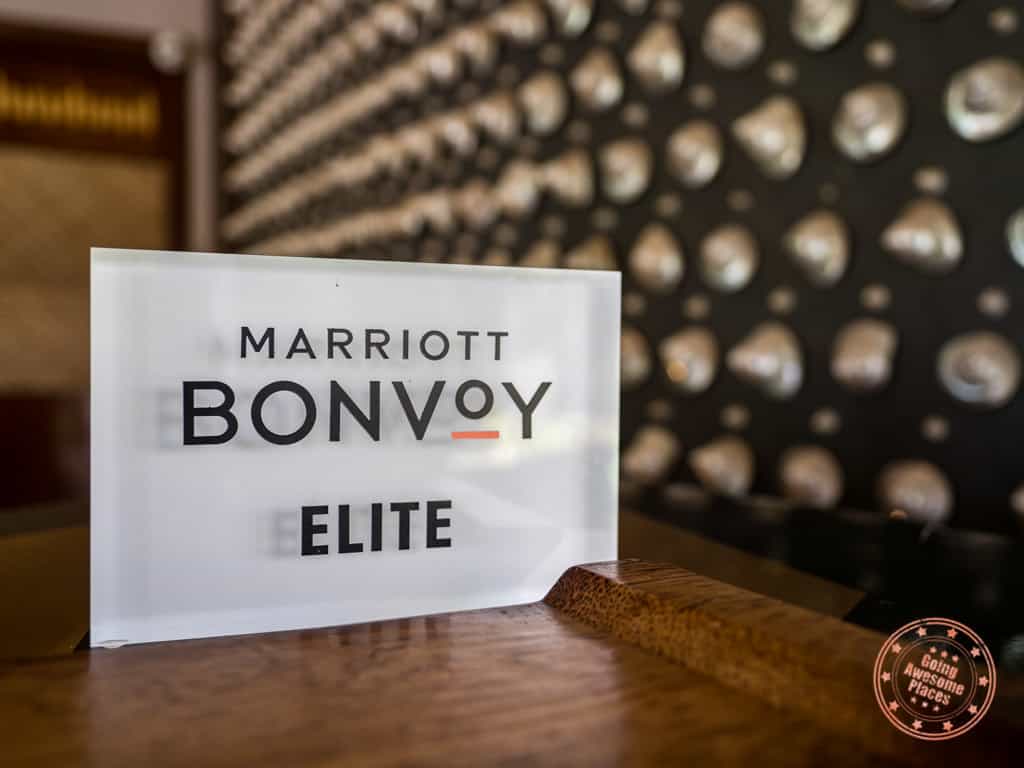
I’m not going to lie, The Islands of Tahiti isn’t known as a budget destination. That said, there are smart ways to travel through French Polynesia affordably. It comes down to some travel hacking smarts, careful planning, and reading a guide like this.
This is why a trip to Bora Bora on a budget is possible but this applies to anywhere in French Polynesia.
Start collecting hotel and airline points
Two of your biggest costs for a trip like this is going to be the flights and accommodations. If I told you that you could lower these costs to practically free, would you believe it? That’s exactly what we were able to do for our 16 day French Polynesia itinerary.
Le Meridien Bora Bora with Marriott Bonvoy Points
For a 5 night stay, it costs 240,000 Marriott Bonvoy points and 1,000 XPF ($10 USD). If you were to book this directly without points, it’s 432,239 XPF ($3,878 USD). How you do it is simple but you just need to know how to strategically collect these points.
- Sign up for the Marriott Bonvoy American Express where you earn a 50,000 welcome bonus after you spend a minimum of $1,500 in your first 3 months. This Card has a $120 CAD annual fee.
- Spend on the above Card to earn 2 points for every $1 on all card purchases or 5 points for every $1 spent at Marriott properties.
- Stay at Marriott properties to build up your Marriott Bonvoy balance and take advantage of quarterly promotions that you have to explicitly sign up for.
BEFORE YOU CONTINUE
If you want to know how to go to Bora Bora for free, you’ll definitely want to read this.
United Airlines flight from Toronto with Aeroplan points
Similar to hotel loyalty points, airline loyalty points more or less work the same way. The goal is to spend a few years to build up your cache of points by leveraging of credit cards, promotions, flying, and other special programs.
To give you an idea of what it cost us, a round trip flight from Toronto to Tahiti with a transfer in San Francisco with United Airlines only required 180,000 points for the two of us and $315.92 CAD in taxes and fees. Contrast this to $2,766 CAD if you had to pay full fare in Economy.
Here’s what I recommend if you’re with Aeroplan.
- Sign up for the American Express Gold Rewards Card which has a welcome bonus of 25,000 Membership Rewards points. These points can be converted to Aeroplan 1:1. This has an annual fee of $150.
- For those wanting to accelerate even faster, there’s The Platinum Card where you can get up to 25,000 bonus Membership Rewards points. The annual fee is $699.
- Lastly, the latest helpful Card to think about is the American Express Cobalt Card where you can earn up to 30,000 Membership Rewards points. This Card has a monthly fee of $10.
- Spend on the Cards you sign up for, meet their minimum spend thresholds to receive the welcome bonuses, and quickly you’ll have enough points with Aeroplan to redeem flight rewards.
It is also good to know here that Membership Rewards points can also be transferred to Marriott Bonvoy if you’re short.
Pack food and snacks from home
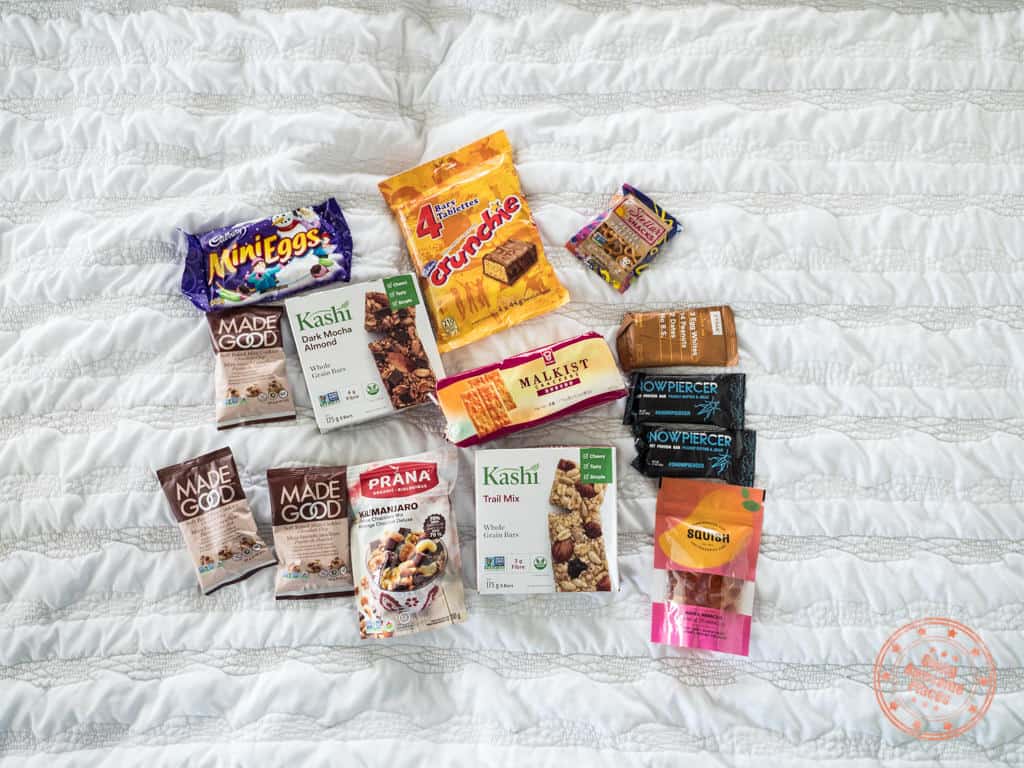
This may sound silly but this is a great cost-cutting measure that we always do. These are food items that you can keep in your day pack or in your accommodations to help curb your hunger as an alternative to ordering food. Snacks make great meal replacements in a pinch. Bringing food for dinner is also a great option especially for expensive resorts.
These don’t need to take up a lot of space but here are a few ideas for things to bring.
- Trail mix
- Oatmeal
- Candy (chocolate not recommended especially in hot climates where it might melt)
- Cup noodles
While this isn’t necessarily food, bring a re-useable bottle that you can fill with boiled water or transfer from larger bottles of water so you make a smaller impact on the environment.
Tahitian guesthouses
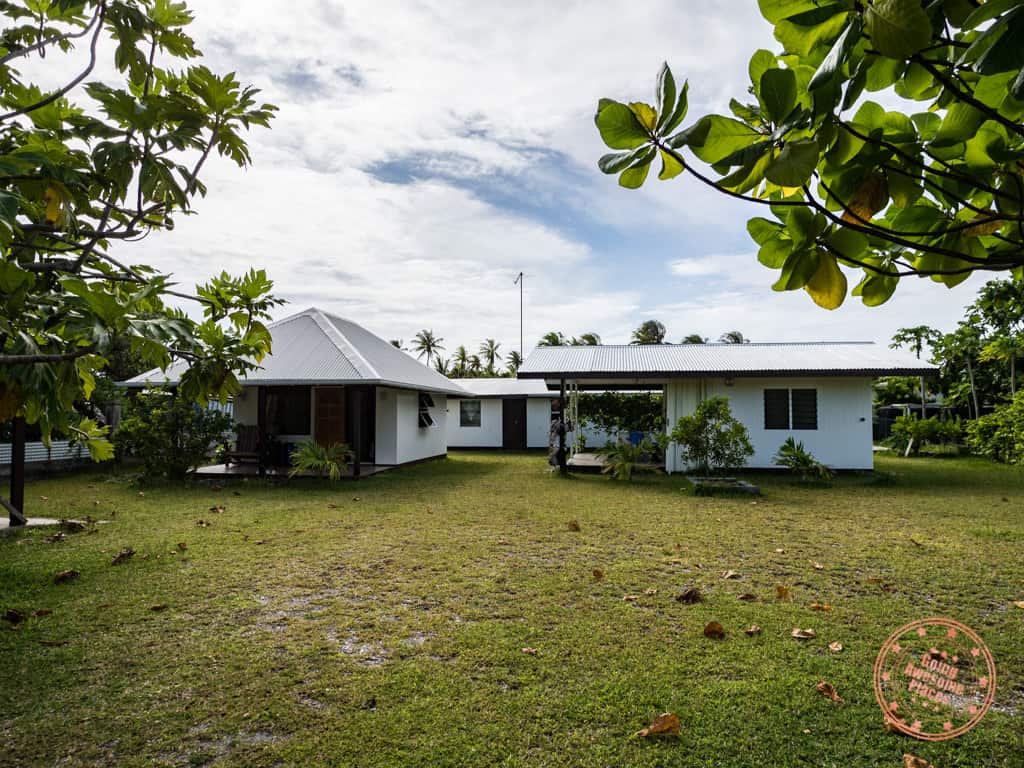
Most of us think about the large fancy resorts and overwater bungalows but these are vastly outnumbered by local accommodations that dot each of the islands.
The Tahitian guesthouse experience is one that is not only authentic, “ocean to table”, experiential, but also incredibly affordable. Locally, these are called pensions.
These properties range vastly and can cater to any travel preference. You can find ones that have dozens of rooms, others with a few bungalows by the beach, or others up in the mountain. Some are all-inclusive private houses and others can be guest rooms offered by a local family where you get to have shared meals with them.
When planning your trip, don’t just go straight to the big hotel chains. Take a look around on platforms like Booking.com and see if there are Tahitian guesthouses or pensions that can help you save money and give arguable an even better experience.
On islands such as Fakarava and Rangiroa, I’ve put together a collection of the best pensions.
Hotel status matters
Don’t overlook hotel loyalty program status. One key feature of the Marriott Bonvoy Platinum status is that you’re eligible for free breakfast. For resorts such as Le Meridien Bora Bora, this is critical because breakfast alone can cost $50 USD or more per person.
One travel hack is to eat late breakfasts everyday to turn it into brunch. This makes a huge difference in cutting down your expenses while staying at resorts.
Save on foreign transaction fees
You might not know this but when you use your credit card overseas, they add a hidden 2.5% rate charge on the exchange rate. To avoid this, think about a card like the Scotiabank Passport Visa Infinite Card which doesn’t charge foreign transaction fees. There are only a few cards with this feature so it is definitely handy to have this one in your wallet.
What to pack for your trip?
I do a full breakdown in the Tahiti Packing List article so find out more there.
Where to stay in French Polynesia
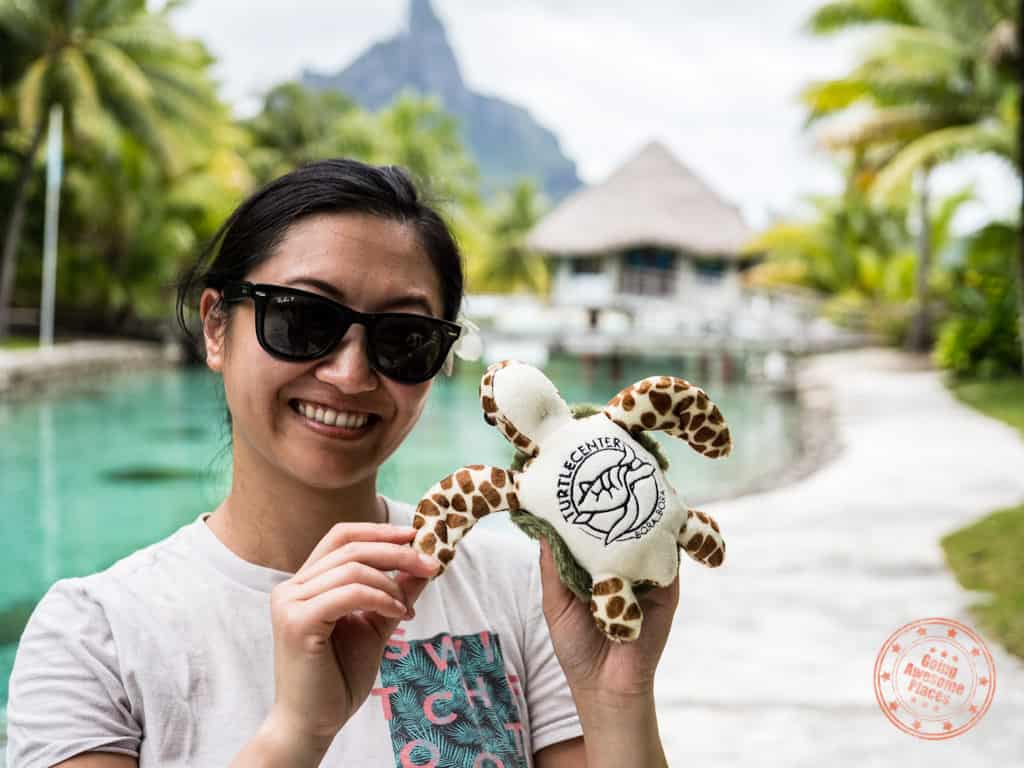
In many ways, how you plan your trip will depend on the accommodations you want to stay at especially if a big resort in Bora Bora is in the mix. As I mention above in the “How do you save money?” section, don’t forget about Tahitian guesthouses.
Here are my recommendations for properties on each of the islands that were part of our 2 week Tahiti itinerary.
Tahiti
WE STAYED HERE

This is a unit in a gated residential apartment complex that is super private and complete with an ensuite bathroom and kitchen, making it a perfect apartment rental. It has a beautiful sunset view of Moorea from the window.
TAHITI LODGE
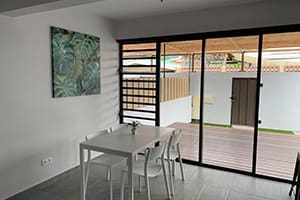
This is a super modern lodge with spacious rooms and shared bathrooms in Papeete. The rooms are a bit barebones but you get breakfast included and large lounge/kitchen area.
GUESTHOUSE IN THE CITY
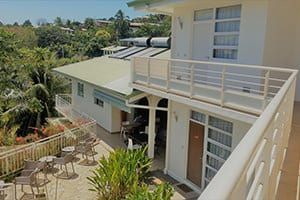
This is a lovely guesthouse in Papeete that is highly rated and very reasonably priced (under $100 USD). Guests have access to a shared lounge area and terrace to relax on. They also have free airport shuttle and free parking.
LUXURY
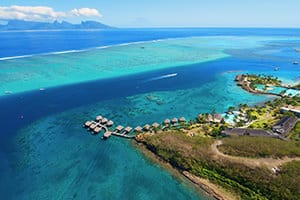
This is probably the best resort on Tahiti with a mix of overwater bungalows and traditional hotel rooms. The rooms are luxurious with excellent views and on-site is the highly rated Lotus restaurant, dive centre, and spa services.
Bora Bora
WE STAYED HERE

While I will say it’s half a star away from the top luxury resorts, for the points and cash you have to spend to secure a reward stay here, you really can’t beat Le Meridien for its strategic position in Bora Bora and amazing views of Mt. Otemanu.
BUDGET
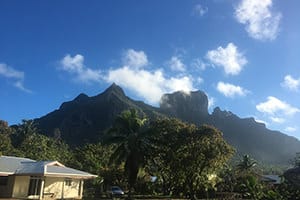
This is a Tahitian guesthouse and perfect for those wanting to a local/budget experience. This property is located by Matira Beach, main town centre, and the dock. Pick up is free from the airport.
MID-RANGE
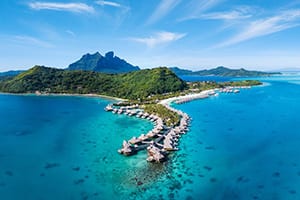
Cream of the crop of properties in Bora Bora and a top choice for anyone with Hilton Honors points. Price wise, they’re actually comparable to Le Meridien surprisingly. Suites are massive but only knock is that it doesn’t have Mt. Otemanu views.
BEST
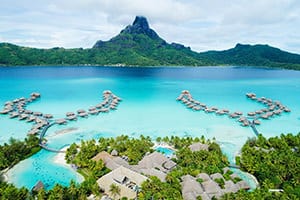
This 5-star resort is arguable the top property in Bora Bora. From the massive suites, the amenities, the spa, restaurants, and private beach, everything is of the highest standard. The staff will often go out of their way to make sure you’re taken care of.
Rangiroa
These are the top 4 properties I’d recommend but also make sure to read the full listing of Rangiroa pensions to know all of your options.
WE STAYED HERE
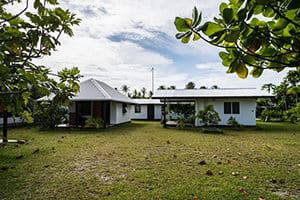
Modest Tahitian guesthouse accommodations amongst a local neighbourhood that is quiet and secluded. Wifi is strong and basic breakfast supplies are provided. Get a real sense of what it’s like to live in Rangiroa here.
ANOTHER PENSION
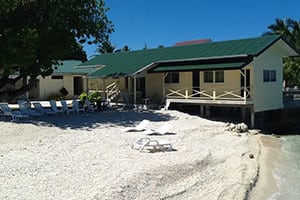
Located in the Avatoru motu and near the airport, this is a beachside guesthouse with shared lounge and kitchen, bbq, free parking, garden, and private beach. Dorms and suites are available.
MID TO UPPER-RANGE
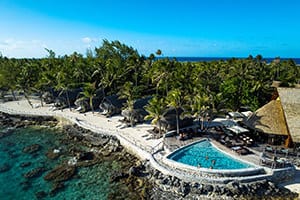
If you fancy living in a Polynesian-style bungalow on the Avatoru motu, this is a perfect resort property that includes a weekly activity program including Poisson Cru show, flower crown presentation, and Tahitian dance lessons.
LUXURY
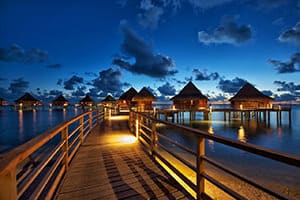
The top property in Rangiroa with a complement of both overwater bungalows, villas with private pools, and beach bungalows. Bordered by white sandy beach and a turquoise lagoon, expect the highest quality of service here.
Fakarava
I recommend that you head over to the best pensions in Fakarava to see a comprehensive look at all of the properties available.
WE STAYED HERE
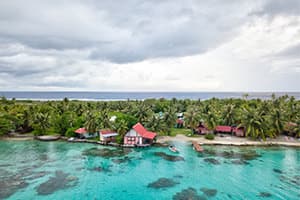
This is a property that is broken up into many small bungalows along the beach, each of varying sizes and some which are en-suite and budget ones that aren’t. Wifi is available but only at the dining/lounge area. Breakfast and dinner is included and bundled in the price.
NEW PENSION
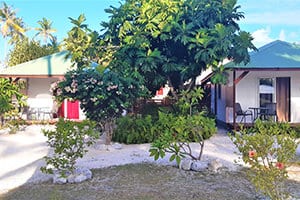
Two new and modernly built bungalows by the beach and located in the village of Rotoava. Rooms are air conditioned which is a key feature. Breakfast, dinner, and round trip airport transfers are included.
CLASSIC PENSION
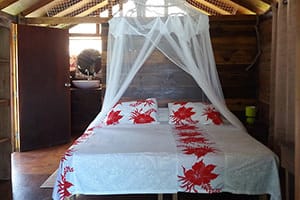
All-inclusive family guesthouse that is right by a sandy beach and fringed by coconut palm trees that includes breakfast and dinner.. There are 6 bungalows total and 4 types. Airport transfers are not included but they do include bikes, kayaks, and a visit to a pearl farm.
RESORT

This is the only proper resort with a collection and beach and garden bungalows, a full restaurant, gym, bikes, kayaks and canoe, snorkels/fins, table tennis, table football, and library. Being an old pearl farm, there’s also a chance to visit a pearl farm and open an oyster as well. Units all have air condition.
From all of our stays, here is what I learned:
- Air condition makes a difference. Many Tahitian guesthouses don’t have this so if you have difficulty sleeping in heat, make sure it’s one of your search parameters.
- For stays on atolls, pay attention to whether a ferry is required to get to a guesthouse. If this is a dealbreaker, don’t book those that aren’t connected by land to the airport.
- While it may feel like you have less control, we learned that having meals included at our Tahitian guesthouses to be advantageous because on smaller islands, it’s not easy to order/pick up food. We enjoyed these benefits at Pension Paparara.
- Free bicycle rentals are pretty important especially if you’re not staying on a resort. If they are not included, find out how much it costs to rent.
- Only resorts have complimentary snorkel rentals. If you’re lucky, Tahitian guesthouses might have a few lying around but there’s no guarantee that they’ll fit you. If you’re serious about snorkelling on your own, make sure to pack them in your suitcase.
- Packing a headlamp or flashlight is a good idea as there might not be good lighting outdoors at night between bungalows.
Best time to go
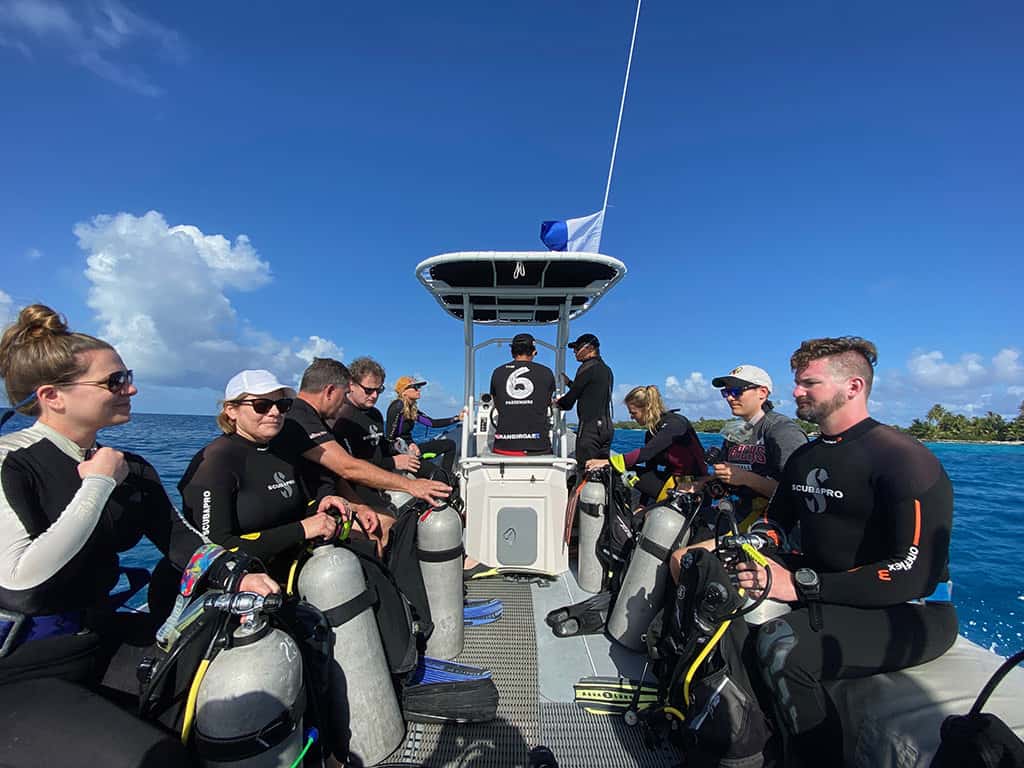
French Polynesia has two primary seasons – wet and dry season.
Dry Season (May – October)
This is the most pleasant time of the year to come with averages of 28°C (82°F), and early mornings dropping to 20°C (68°F).
This season is also known as austral winter as you have to remember that French Polynesia is located in the southern hemisphere.
While the weather is more pleasant, the months of July and August are the busiest with tourists since it coincides with holidays in France and Heiva Nui, the territory’s largest annual festival.
If you’re looking for the best weather overall, June to September is the most optimal since it is the coolest and least rainy.
Wet Season (November – April)
Also known as austral summer, this is when the rainy period of the year where average temperatures sit at 30°C (86°F) and evenings drop to 22°C (72°F).
While there are chances of rain during these months, typically these are tropical storms which means they come and go quickly. Even though forecasts will show rain, on average these are light showers that pass through between intense sunshine.
From December to April there are risks of cyclones. That said, French Polynesia is less affected by these cyclones in the Pacific because they usually form on the western side of the ocean.
Differences between archipelagos
Another factor to consider is that the weather varies as you go from archipelago to archipelago. Starting from the Society Islands, this belt usually sees more rainfall during the wet season.
The Tuomatus have warmer temperatures and less rainfall since all the islands here are atolls and there are no mountains to create the cooling effect and formation of clouds.
The Marquesas as the closest to the equator so temperatures and humidity are higher than the rest. Their rainy season is actually the opposite from the rest of the country with most of it dropping from June to August.
The islands to the south, Austral and Gambier islands are cooler all year round.
Best times for scuba diving
The “best time to go” equation becomes drastically different when you think about spotting certain wildlife. Here are a few notable species that many will often be seeking:
- Whales – July to November. The best island to spot humpback whales is Rurutu.
- Hammerhead Sharks – These are more of a rare sighting but are present mostly in the Tuamotu Islands. The Marquesas Islands highlights hammerheads between July and September.
- Manta rays – They can be seen all year round but they’re even more present in the months of July to September
How much does a trip to French Polynesia cost?
If you’ve come from the 16 Day French Polynesia Itinerary, you’ll know that I didn’t do a breakdown of total costs so to give a frame of reference for what to expect when planning a trip, this is a breakdown of how much we spent after employing a bunch of those cost saving tricks.
To give you an idea of how much a 16 day trip costs for two people converted to $USD, I’ve broken down the costs by category.
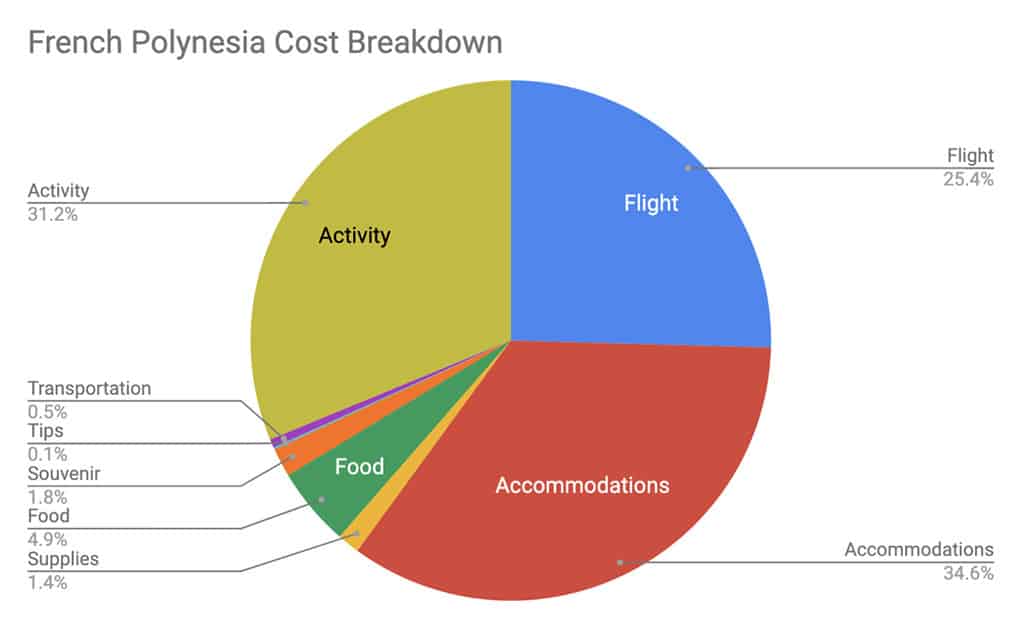
This breaks down to $5,689.43 total, $2844.72 per person or $177.79 per person per day.
What’s crazy about this is that compared to the cost of the trip for Egypt or Greece (cost breakdowns inside), this vacation was actually more affordable. Now that came to me as a big surprise.
How did we do? I’d say that we had a good balance of a trip that combined the luxuries of Bora Bora with off-the-beaten-path and roughing-it adventure elements of the atolls.
5 main take aways
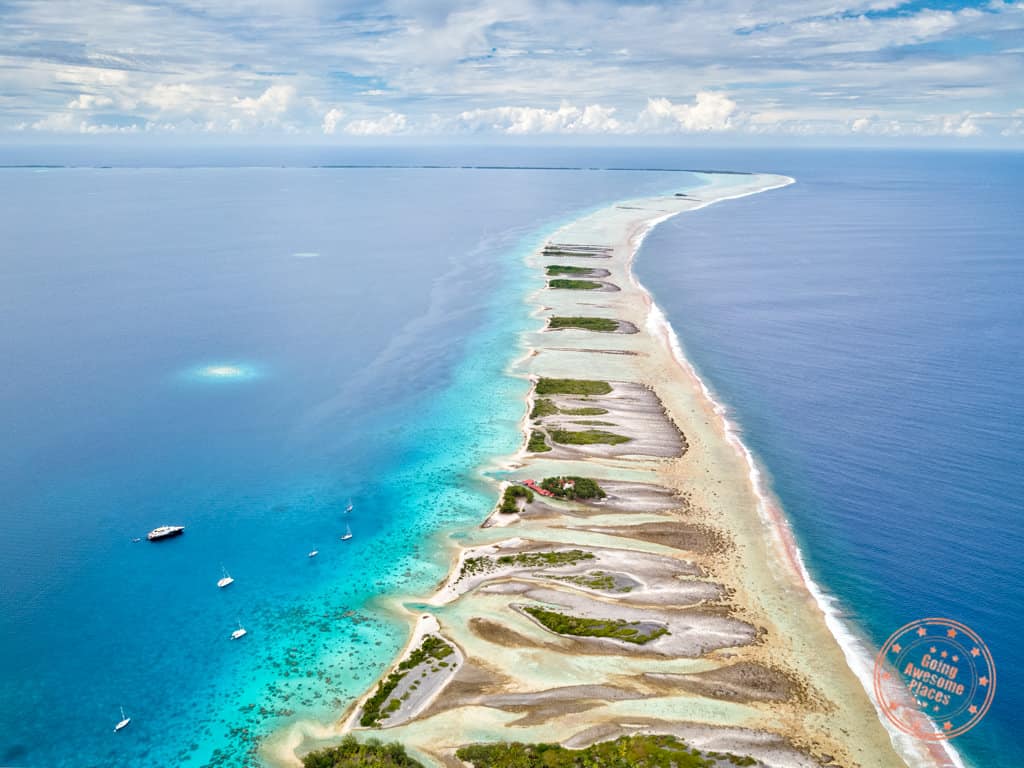
In this things to know before you go to Tahiti travel guide, we hope you’ve come away with a ton more information than you were looking for or thought you needed to know.
Here’s our 30 second pitch for the 5 key takeaways from our trip.
- The scuba diving here is some of the best in the world. Sharks galore!
- We absolutely loved Le Meridien Bora Bora and the overwater bungalows were ridiculous but so worth it.
- There’s an energy and spirit about French Polynesia that you’ll embrace.
- While not as posh, our life on Rangiroa and Fakarava were some of the most memorable experiences, living that simple island life.
- We would go back.
Have specific questions about building your own French Polynesia itinerary? Drop a comment below in this things to know before you go to The Islands of Tahiti travel guide!
What you should read next

